Every video game publication at some point does their own “Best Video Games of All Time” list, almost always inspiring silly discourse and angry internet comments. After nearly a decade of this site’s existence, we at The Punished Backlog finally decided we want in on the fun!
Making lists like these—lists that convey some level of conviction and finality—is hard. Creating a clear methodology is hard. Figuring out what games belong on your own personal top 50 list is hard, especially if, like many of us here, you play a LOT of games. Deciding what to actually say about the titles that make the list is hard. Doing all this purely because we think it would be fun to do so is also hard.
We wanted to make a list of games not that we necessarily feel deserve to be named the best ever, but that allow us to talk about our favorite experiences on our terms. Sure, most of the titles you’ll see have reached a certain level of fame and prestige, but nobody contributing to this list felt any need to check any boxes or appease phantom gatekeepers. No, we voted on the games we loved the most, angry commenters be damned.
Methodology
Before we get into the list itself, just a few notes on how we actually made it:
- 12 contributors at The Punished Backlog submitted lists of their top 20 games of all time.
- The order of the overall top 50 list was determined by a ranked-choice voting system, with the top-ranked game on each list given 20 points and the bottom-ranked game getting one point.
- In the event of a tie, priority was granted to the game that appeared on more lists, with other kinds of tiebreakers applied in the event that multiple games had the same number of points AND appeared on the same number of lists.
- Each entry includes a list of platforms, which are ordered by release date. If a platform no longer exists (e.g., the 3DS/Wii U via eShop), that platform was left off the list.
One Last Note…
I know, I know! You want to get to the good stuff. Still, I just wanted to take a minute here to thank every single writer who contributed to this list, especially fellow editors David Silbert and Amanda Tien for helping out with any editorial work (and for just being incredible people). Everything we do on this site is a labor of love, and making a list like this is always going to be a complicated, daunting task. I’m thrilled that we were able to do it at all, and delighted that we got to make something that really reflects who we are as writers, gamers, and human beings.
Most importantly, thank you for reading this and anything else on our site.
– Written by Sam Martinelli
Table of Contents
Want to hop to a specific section of this list? We won’t spoil the results, but you can hop to various segments by using our handy table of contents:
Our Top 50 Video Games of All Time

50. Donkey Kong Country 2: Diddy’s Kong Quest
Somehow, a game about clothed monkeys jumping on top of crocodile-people dressed as pirates is still one of the most emotionally resonant games I’ve ever played.
Few games matter to me as much as Donkey Kong Country 2. It’s not just the excellent platforming challenges, mesmerizing soundtrack, and haunting world design; it’s the care, the precision, and the incredible level of atmospheric storytelling rarely found in modern Nintendo games. Every single playable stage is its very own vibe, one marked by danger and distress but simultaneously hope and amazement. The hazards can be fierce, but the excitement is worth it.
This isn’t the first time I’ve written so glowingly about Diddy’s Kong Quest (and likely won’t be the last), but the one aspect of the game I keep going back to is how singular and inimitable it continues to be nearly 30 years later. No new game today—not from Nintendo, another AAA publisher, or any indie studio—would look and sound quite like DKC2 does. No other platformer would give the player as little information on screen as it does, and no other title ostensibly designed for children would trust them enough to look for secret collectibles in such unconventional places. DKC2 is an all-time great game, and the greatest shame about it is we’ll never see anything like it again.
Platforms: Super Nintendo, Game Boy Advance, Nintendo Switch (via Nintendo Switch Online)
– Written by Sam Martinelli
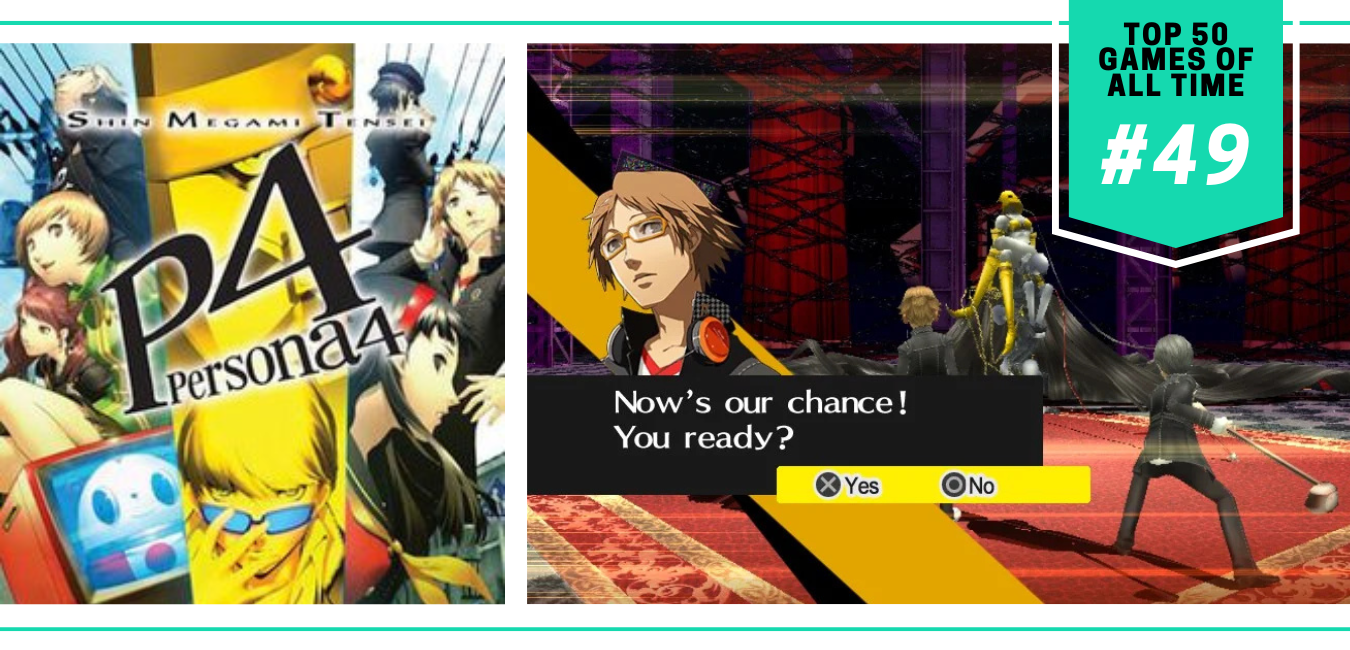
49. Persona 4
High school is hard, even for folks who “have it easy.” Between homework, after-school activities, inattentive parents, and jumping into a TV inside a Fantasy Walmart, it can be really tough! Even tougher for the Investigation Team in Shin Megami Tensei: Persona 4 (2008) who have to balance all those things AND try and date each other! How do you find the time?
Persona 4 was the catalyst for the Atlus revolution in the states and vaunted the series into household name status. And personally, it is the RPG that I have replayed the most and look back on most fondly. I love the relationships within the Investigation Team and the revolving world around Inaba. Stories like the Kuroda Social Link and Dojima Family struggles still resonate with me to this day. While it’s not the cleanest story (I still wish the creators had been brave enough to make two of the characters gay/trans), Persona 4 remains a confident and touching story. Found family is a common trope in games, but Persona 4 knocks it out of the park.
On the gameplay side, adding the option to directly control your party members was a game changer: no more hoping your party members use the correct elemental attack. Persona 4 refined a base for great games to be built upon, and deserves recognition for it today.
Platforms: PlayStation 2, PlayStation Vita, PC, Nintendo Switch, PlayStation 4, Xbox One, Xbox Series X/S
– Written by Gary Wilson
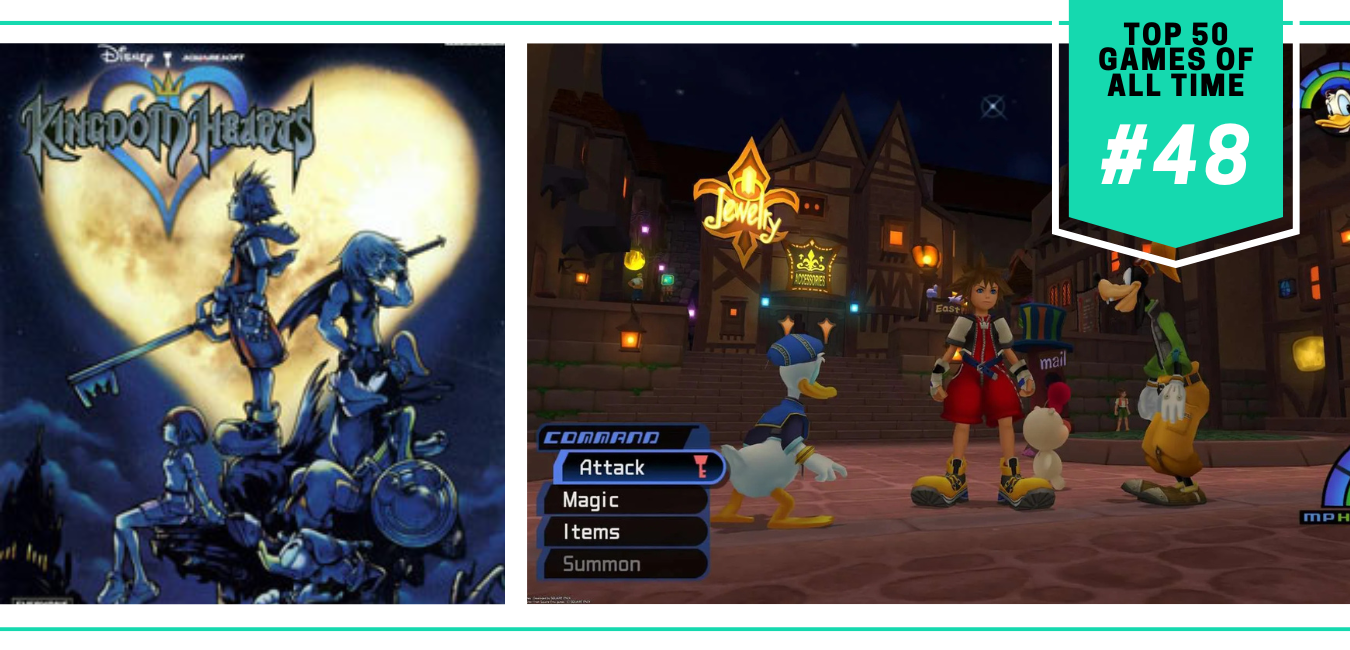
48. Kingdom Hearts
I have a complicated relationship with the Kingdom Hearts franchise, mostly because it has a complicated relationship with itself. By that, of course, I mean that none of the games make any sense whatsoever and are unbelievably convoluted in story, mechanics, and plot… EXCEPT for the original.
It’s a real shame the magic of the first Kingdom Hearts could not be replicated, because magic really is the only way to describe it. With its unique blend of original characters mixed with beloved friends from Disney and Final Fantasy, every minute of this adventure is packed with pure joy.
The fact that it spawned a series with roughly 500 sequels should be proof enough of its merit, but when I think of why it should be on a greatest games of all time list I think mostly of how it felt playing it as a kid: majestic. It’s full of charm and excitement but also deep sadness and exploration of grief. The battles are just as epic as the cutscenes, music and hearing Goofy say “GAWRSH” for the thousandth time. Going from planet to planet, customizing your ship (if you can figure out how), and carving up baddies like Ursula and Hades make for an unforgettable experience I think everyone should try. At times it truly feels like a fever dream, but I don’t think I spent more time with any other game on my PS2.
Back then, I hadn’t played anything like it before and I still haven’t played anything like it since. Especially since all the other KH titles are so bad I’ve had to give up on every other one. If you’re going to try Kingdom Hearts, make sure you start at the beginning.
Platforms: PlayStation 2, PlayStation 3, PlayStation 4, Xbox One, PC, Nintendo Switch
– Written by Zack Gulinello

47. Balatro
How could Balatro NOT make this list? As a roguelike deckbuilder made by LocalThunk (who is only one person by the way), it’s an incredible feat. You know an indie game is that good if it was nominated for Game of the Year at the 2024 Game Awards.
If you’re unfamiliar with this gem: Balatro has you play rounds of illegal poker hands with power ups like unique Jokers, tarot cards, planet cards, and vouchers. That may sound confusing, because it is at first. Anyway, these resources at your disposal help you manipulate your deck to win each poker blind. The combinations are endless, and with so much to unlock in the game, there’s never a dull moment.
The game also sees continual updates, bringing new card designs inspired by games like The Binding of Isaac, The Witcher 3, Vampire Survivors, and more. You can tell that Balatro was and still is a labor of love for LocalThunk, which brings me hope for the future. What DLC could we see? Could there be another game in the works? With a huge following of gamers and non-gamers, Balatro can do big things to shake up the gaming industry.
The game can easily provide you with hundreds of hours of playtime. Just make sure you have some free time, because Balatro will take it.
Platforms: PC, Mac, Nintendo Switch, PlayStation 4, PlayStation 5, Xbox One, Xbox Series X/S, iOS, Android
– Written by Allison McDaniel
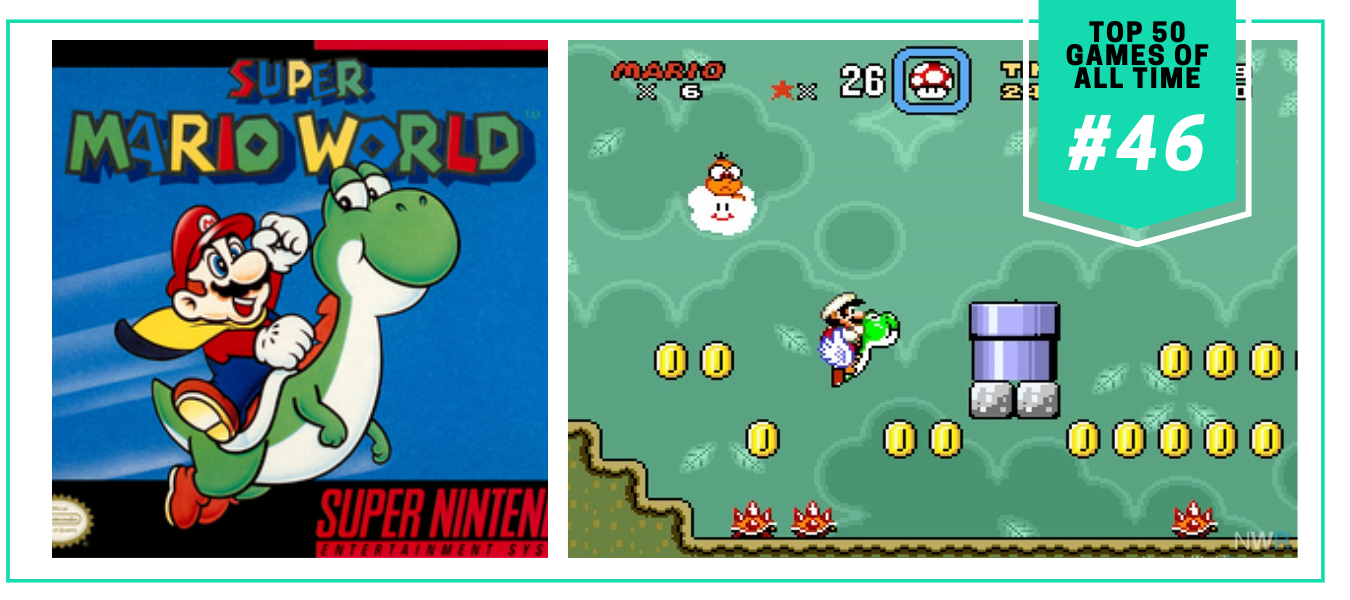
46. Super Mario World
What makes Super Mario games still so important and so relevant after all this time is that, at their zenith, they contain the best that gaming as a medium has to offer: a basic set of controls that anybody can learn but still require precision and practice at times; beautiful, lushly animated assets and environments that inspire curiosity; and the exact right measure of ease and challenge that give novices and experts alike moments of bliss. No game in the Mario oeuvre exemplifies these elements as well as Super Mario World, the very first game for the Super Nintendo.
Mario World has enough obviously amazing things going for it to warrant inclusion on this list—the introduction of Yoshi alone should be enough—but what allows it to stand the test of time is how perfectly balanced every part of it feels. The actual platforming mechanics are smooth as hell, yet there’s just enough difficulty in later levels to really test the player’s mettle. The level progression is straightforward enough, but there’s also secret exits and alternate pathways everywhere. Super Mario World, essentially, is as hard or as easy as the player wants it to be, and loads of joy regardless of how you choose to play it.
The more I think about it, the more I believe Super Mario World should be “required reading” for anyone writing about video games. It’s a masterclass in overworld architecture, art direction, sound editing, movement mechanics, and level design. It may seem as simple as a mustachioed plumber jumping around in forests and caves, but every second is so meticulously designed and teeming with wonder that it never feels that simple. A masterpiece for the ages.
Platforms: Super Nintendo, Game Boy Advance, Nintendo Switch (via Nintendo Switch Online)
– Written by Sam Martinelli
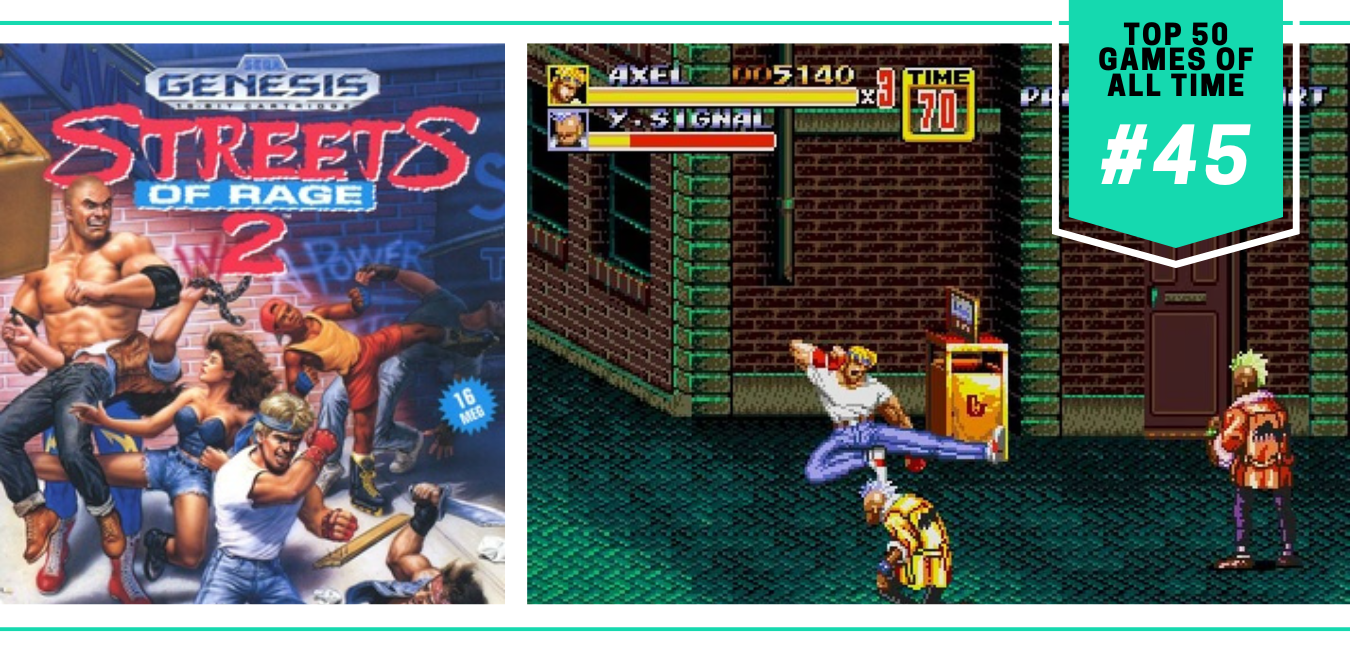
45. Streets of Rage 2
I first discovered Streets of Rage 2 through the Sega Smash Pack Vol. 1 on the Dreamcast—still my favorite system of all time, by the way. That collection was packed with Sega classics like Altered Beast, Sonic the Hedgehog, Golden Axe, and Virtua Cop 2, but Streets of Rage 2 instantly captivated me on multiple levels.
The first thing that grabbed me was the character Eddie “Skate” Hunter. As a young Black kid in the early 2000s, I rarely saw characters in games who looked like me. But there was Skate: a Black boy, seemingly around my age, who wasn’t just in the game—he was out here fighting grown men with pipes, bats, and even katanas. Playing as him felt genuinely empowering. Every time I picked up the controller, it was pure wish fulfillment, an unbeatable combo of escapism and representation. (Granted, some of the enemies were also Black men named Donovan, which, as someone named Donovan, was a bit confusing—but I’ll let it slide.)
The gameplay itself sealed the deal. While Streets of Rage 2 wasn’t the first side-scrolling beat ’em up I’d played, it was the one I kept coming back to. The combat was instantly satisfying: easy to pick up, with smooth combos and unique moves for each character. The incredible, complex, genre-defying soundtrack, gritty cityscapes, and fluid co-op play elevated it even further. Decades later, Streets of Rage 2 still stands as one of the genre’s defining masterpieces, and a game that meant the world to me growing up.
Platforms: Sega Genesis, Game Gear, Master System, Nintendo Switch, PlayStation 4, Xbox One, PC
– Written by Donovan Harrell
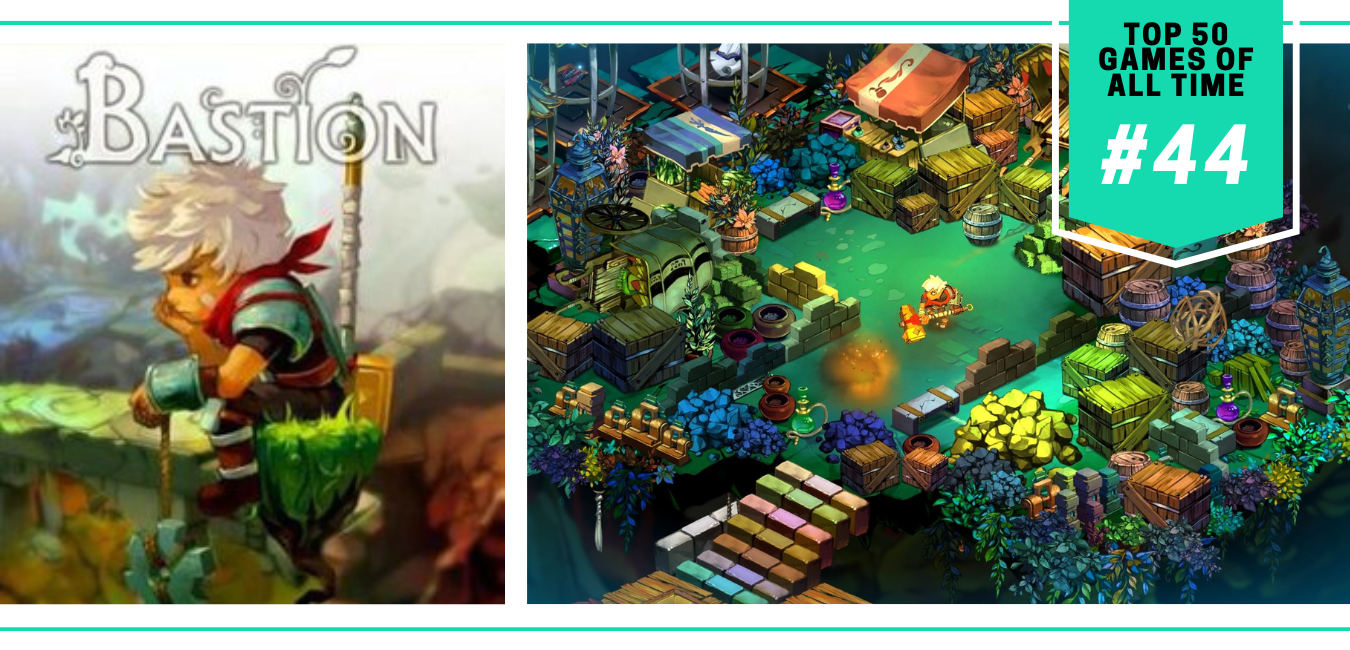
44. Bastion
Something forgotten in the current gaming space is how exciting Microsoft’s annual Summer (or Winter for our Southern Hemisphere friends) of Arcade was. Every summer, Xbox Live Arcade would feature five indie games all over the main storefront and incentivise players to try them. As a teen, it was an amazing way for me to find games that I still love to this day. It all started with Braid and Castle Crashers in 2008, and ended with Brothers: A Tale of Two Sons and Charlie Murder in 2013. It is not hyperbolic to say that Summer of Arcade kick-started the indie revolution and built within me my love for small games from small studios. This website may not even exist without Summer of Arcade bringing indies to the forefront.
For me personally, the greatest Summer of Arcade came in 2011 with the release of Supergiant’s Bastion (well, and also Insanely Twisted Shadow Planet but I’m not here to talk about that). I have already written at length about what Bastion means to me, but few recognize what Bastion started in the industry. Of course, games like Transistor and Hades would not be there without the strong success of Bastion as future Supergiant projects. But Supergiant also allowed cameras into their offices during development, allowing people to see what it takes to create art. Giant Bomb’s Building the Bastion series opened my eyes to what developers go through, what iteration processes look like, and just how god damn hard it is to ship games.
Documentaries about games are pretty commonplace now, but completely revolutionary at the time. I can only imagine the generation of creators who saw inside that studio and said “I want to do that. I want to make games like that.” Games that have joy and passion at their core. Games that mean something to the people making them, and the people who play them. Games like Bastion.
Platforms: Xbox 360, PC, Mac, Linux, iOS, PlayStation 4, PlayStation Vita, Xbox One, Nintendo Switch
– Written by Gary Wilson
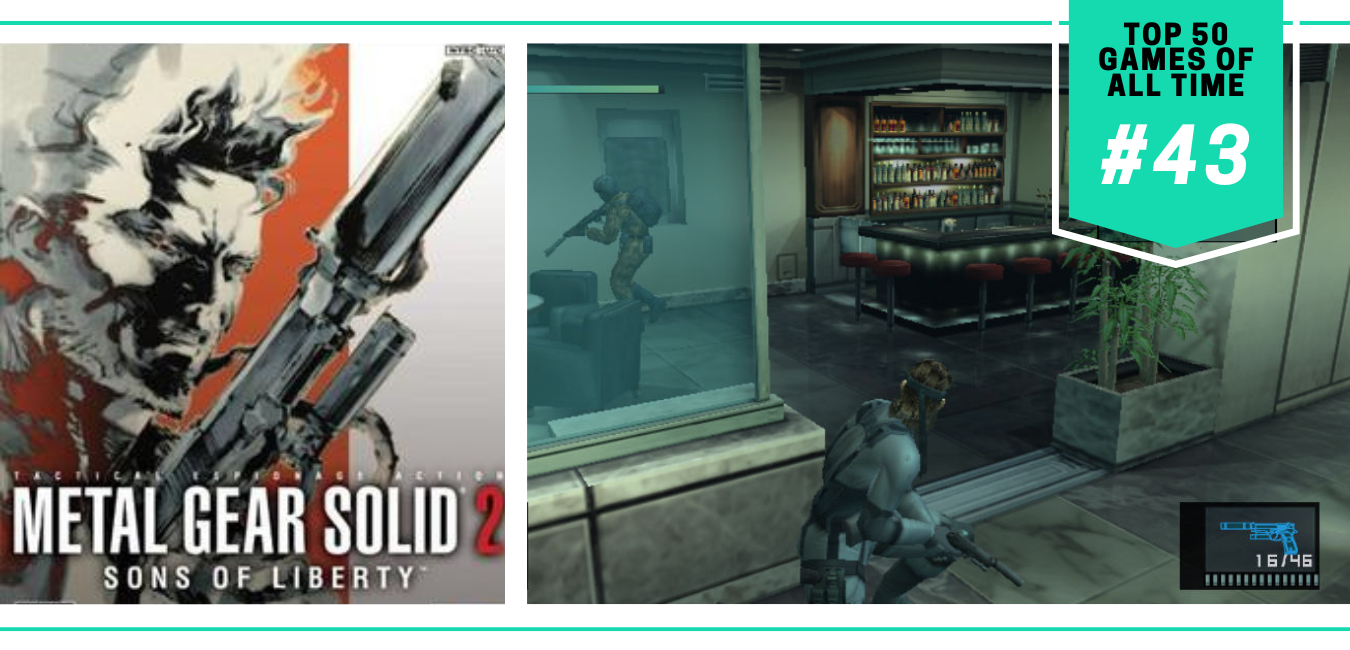
43. Metal Gear Solid 2: Sons of Liberty
Metal Gear Solid 2: Sons of Liberty is Hideo Kojima’s masterpiece. It should be an essential game to play for any modern game writer, postmodern theorist, or English major. Its narrative gave gaming its first postmodern experience. The fake-out advertising campaign that claimed players would once again play as Solid Snake paired with the opening Tanker mission was only the beginning of the mind games at play in MGS2.
I’ve said it before, but it is always worth reiterating as it may explain my career choices and some of my politics: I was far too young to play MGS2 when I first picked it up. The world caught my imagination. The stealth mechanics, campiness, and political commentary hold up over 20 years later. For better and worse, Raiden’s narrative still remains uncomfortably relevant today.
The game has aged—the switch between third-person and first-person feels a bit jarring in 2025—but even in his motions, Raiden feels so different from series regular Snake or even contemporary stealth hero Sam Fisher from the Splinter Cell series. The gameplay, including Raiden’s overconfident if not a bit uncertain movement through the Big Shell, captures part of the story itself.
Raiden’s journey continues to hold a mirror up to players in the United States 24 years later. I hope to write more about it in the future. I hope that more of us sit with this reflection and look beyond the facade.
Platforms: PlayStation 2, Xbox, PC, PlayStation 3, Xbox 360, PlayStation Vita, PlayStation 4, PlayStation 5, Xbox Series X/S, Nintendo Switch
– Written by Clint Morrison, Jr.

42. Devil May Cry 5
I was introduced to the Devil May Cry series way too young. It came as a recommendation from a game store employee to my dad, who I’d asked to grab me an action game for the PS2. But once I got to the cursed demon puppets in Devil May Cry, I couldn’t do it—I was too scared to play. Still, I couldn’t stop watching my older cousin style on enemies like it was second nature. It quickly became a defining game for us both.
There’s so much I could say about the Devil May Cry series, but Devil May Cry 5 stands above all as the pinnacle of the hack-and-slash genre. It builds on everything that came before it: the presentation, the music, the gameplay—all elevated to perfection. It feels like a love letter to the franchise, full of callbacks to past bosses, weapons, and moments.
While it’s not without its flaws (I’ve never loved playing as V, to be honest), DMC5 delivers the series’ best story yet: a tale of family, grief, and relentless ambition. It provides long-awaited closure to the arcs of Nero, Dante, and Vergil, while giving each of them satisfying new power-ups that let them grow into their ultimate selves.
DMC5 is my gold standard for modern action games. No other game in the genre has hit as hard since. Each character’s move set is so rich and deep, allowing for incredible freedom of expression and play style. After waiting over a decade for this sequel, I wasn’t disappointed for a second. Nero keeps much of his kit from DMC4, but adds a chip on his shoulder, a missing arm, and a whole arsenal of Devil Breakers—prosthetic arms that range from electric fists to rocket-powered punches, laser cannons, and even a Mega Buster. Dante is at his absolute best, rocking his full suite of styles alongside new weapons both familiar and wild. My favorite? The Devil Sword Dante, a weapon as iconic as the game itself. And Vergil? He’s easily got the best theme song in the game. One could even say it’s… motivational. Also, his toolkit is completely broken and undeniably fun to use.
Platforms: PC, PlayStation 4, Xbox One, PlayStation 5, Xbox Series X/S
– Written by Donovan Harrell
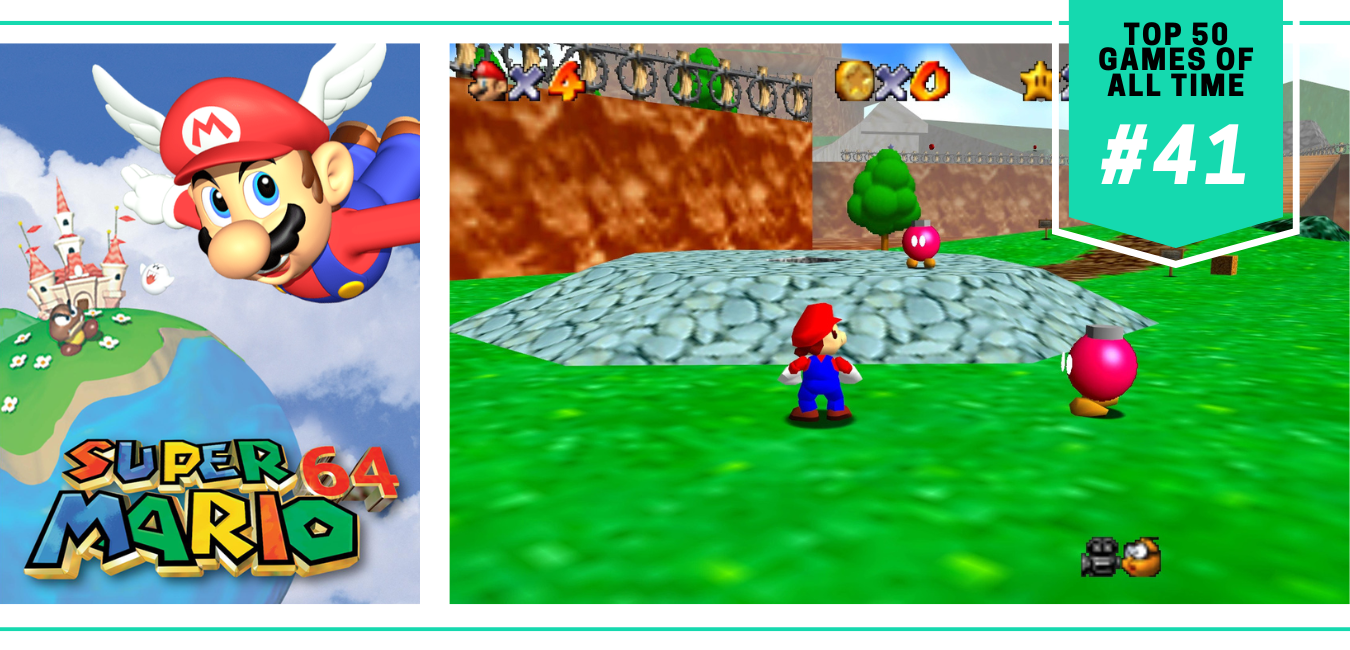
41. Super Mario 64
I’ll try not to quibble with its place on this list too much but Super Mario 64 is my personal favorite game ever. Released in 1996 when I was only two years old, Super Mario 64 deserves a spot here strictly for the grand achievement in gaming history it represented. No longer was our favorite mustachioed plumber confined to a mere two dimensions; He was free to roam anywhere his heart desired! And boy, did he roam.
If I’m being honest, I don’t even care about the fact that this game was a groundbreaking moment for video games. I do care about riding a Koopa Shell like a skateboard around Lethal Lava Land while this little melody dances through my brain bringing me a sense of wonder and bliss I’ve rarely felt since. I should probably think of a better word to describe it than “fun,” but ultimately isn’t that all we’re after?
Each level sets itself apart from the others with the sights and sounds (the soundtrack is truly iconic), but what they all have in common is pure unadulterated fun. Movement is a breeze, the secrets of the castle are a blast to reveal, and every Star feels like a worthy challenge. Even the menu screen is the best ever, with a gimmick I’ve not once seen duplicated where you can pinch and pull poor Mario’s giant face in any direction you choose.
Super Mario 64 stands the test of time as one of the greatest platformers ever created, and one I go back to often just to relive a bit of that carefree joy it gave me back in the day. It’s the ultimate comfort game, like the best pizza you’ve ever had.
Platforms: Nintendo 64, Nintendo DS (Super Mario 64 DS), Switch (via Nintendo Switch Online + Expansion Pack)
– Written by Zack Gulinello
Our Top 40 Video Games of All Time

40. Final Fantasy XII
For decades, the name Final Fantasy was synonymous with unparalleled quality and innovation. From the title that started it all (and supposedly saved Square Enix from bankruptcy) to generation-defining classics like Final Fantasy VI and VII, to more recent lodestars like Final Fantasy X, this RPG giant had always led when others followed.
Nowadays, however, the series has hit some turbulence. Final Fantasy XIII abandoned the non-linear structure of its predecessors for a frustratingly spoon-fed experience. Final Fantasy XIV became a juggernaut, but not before it crashed and burned. Final Fantasy XV was a bit of a mess, and XVI—well, the less said about that one, the better. If the VII remake trilogy is any indication, we’re back on the up-and-up, but the journey hasn’t been a smooth one.
If there’s one Final Fantasy game that doesn’t fit neatly into the “golden age” vs. “dark age” debate, it’s Final Fantasy XII. Beloved by some and reviled by others, XII has dodged much of the series’ modern-day scorn—perhaps because it preceded the Actually Bad XIII, but also because it’s secretly quite good.
Final Fantasy XII takes everything you love about the series—guilty-pleasure melodrama, great music, chocobos—and layers on several innovations. The game eschewed the time-honored “active turn-based” battle system in favor of a real-time spin, complete with MMO-esque cooldown timers. Its “open zone” areas, deeply customizable License Grid, and focus on player positioning paved the way for games like Xenoblade Chronicles, Genshin Impact, and even Square Enix’s own Final Fantasy XIV and VII Remake.
Then, there were gambits: customizable, logic-based commands that enabled players to design their own party AI. Much like coding an intricate program, the Gambit system rewarded dedication and creativity, to the point where players (read: me) could enter a boss battle, go upstairs to fix a sandwich, and let the game do the rest.
The experience wasn’t for everybody. Many deemed gambits “lazy,” and the ensemble cast was almost universally criticized. Heck, I’ll be the first to admit it: Vaan sucks. But those who fixated on XII’s weaknesses missed its greatest strengths. A massive, beautifully realized world. Satisfying combat that tested your mettle. Some of the finest voice acting in any video game, period. Most important of all: the suave sky pirate Balthier.
No matter how you slice it, Final Fantasy XII is gaming’s equivalent of fine wine. Consider 2017’s Zodiac Age remaster, which introduces the job system that North America never got to experience, and XII is one of the deepest, richest, most fulfilling RPGs to grace the disk drive.
Platforms: PlayStation 2, PlayStation 4, PC, Xbox One, Nintendo Switch
– Written by David Silbert
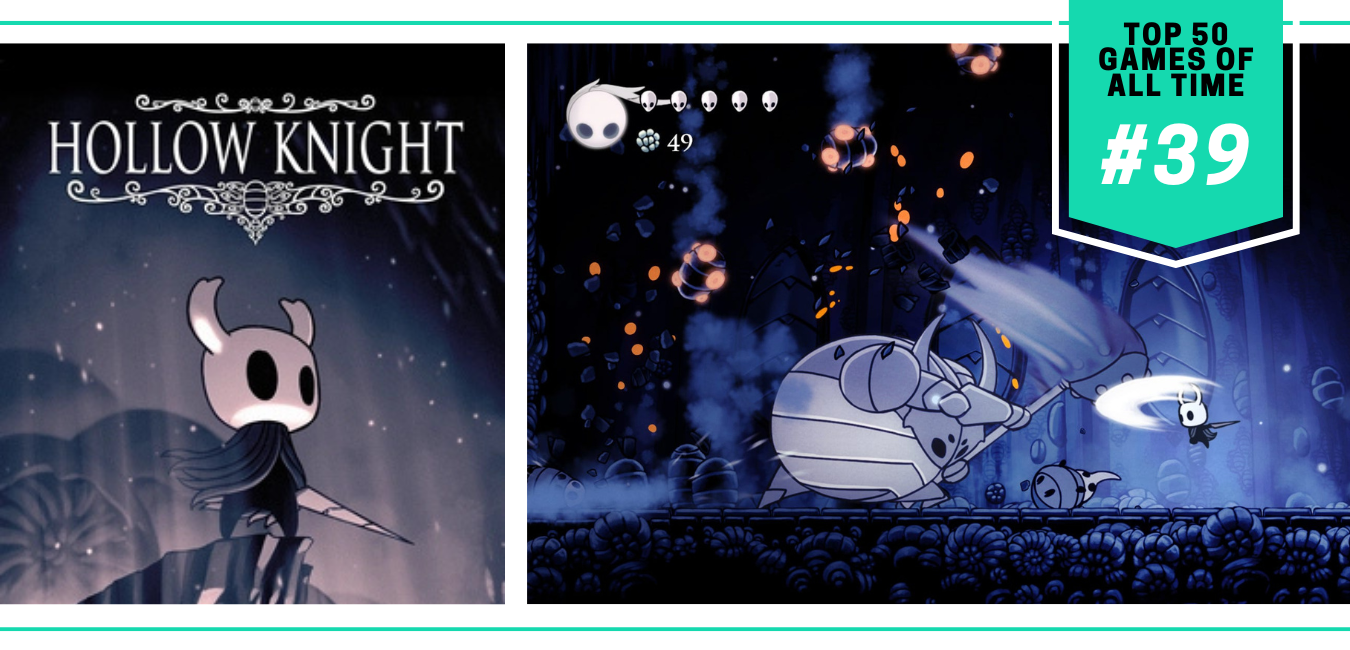
39. Hollow Knight
There are games on this list I have longer and deeper relationships with, but Hollow Knight will always have a special place in my heart for the way it completely consumed me and wouldn’t let up. I wouldn’t have considered myself a Metroidvania fan before Hollow Knight. In fact, the only other one I had really ever fully played at that time was Metroid Dread. I picked that up on a whim after reading some positive reviews and thoroughly enjoyed it, which made me quickly realize I had been missing out on a genre with so much to offer.
Hollow Knight is a quintessential title in the Metroidvania space, but not just because it upholds the standards of the genre so well. Of course the exploration and combat are top notch. No question the nooks and crannies to discover are hidden with intense precision and care. You’d better believe the abilities and upgrades make the whole experience tight and fluid to play. It’s immaculate in every way, but none more so than the atmosphere of Hallownest.
There’s something about the games on this list that defies explanation, that truly relies on vibe to tell the story. I could talk about mechanics that I absolutely loved (like charms) or the map and fast travel system that made navigation just the right amount of challenging. But there is no experience quite like finding the City of Tears for the first time, or exploring Greenpath, or digging around Deepnest in the darkness hoping for an escape. Hollow Knight made me feel things in a video game I didn’t know I could, and if I don’t get Silksong I’m going to feel even more new emotions I don’t think I’m prepared for! I loved every minute of Hollow Knight and sincerely wish I could go back and play it for the first time again.
Platforms: PC, Mac, Linux, Nintendo Switch, PlayStation 4, Xbox One
– Written by Zack Gulinello
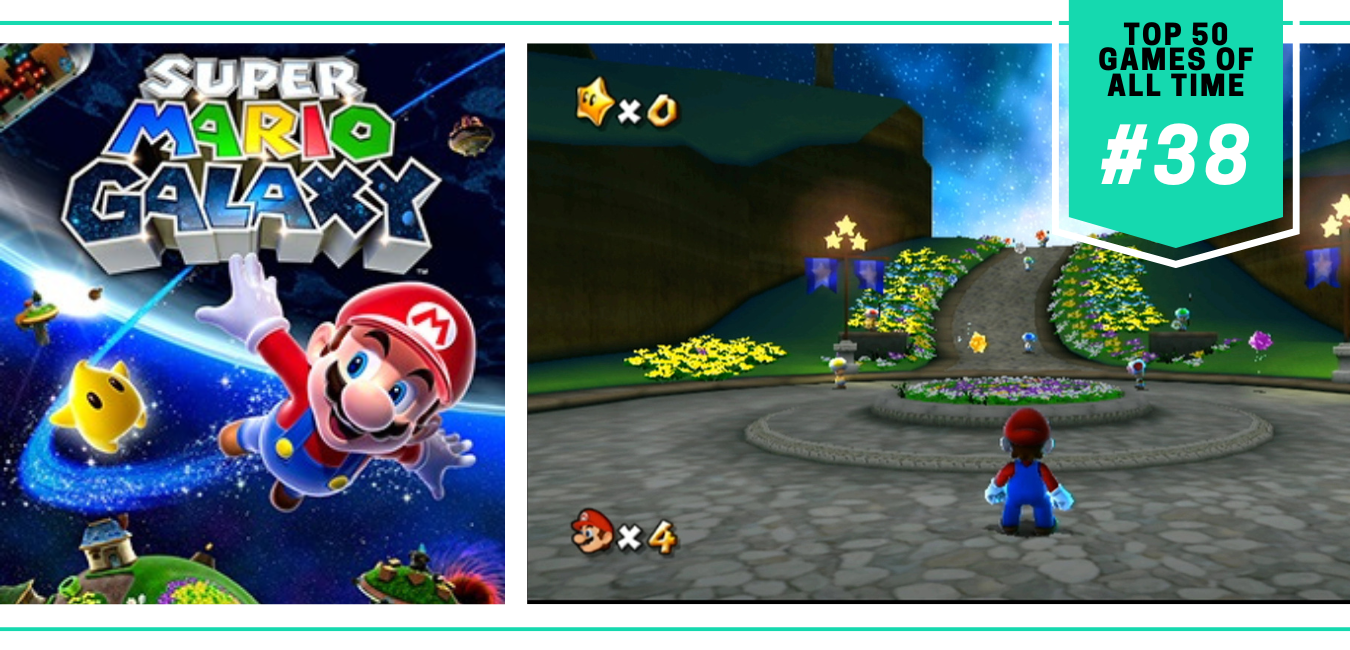
38. Super Mario Galaxy
Video games are often at their best when at their most dreamlike. Even when you have a handle on the rules and regulations defining a digital experience, the most memorable parts make you feel like anything is possible, that you can soar through the stars and encounter a myriad of colorful, playful possibilities. Few titles in the history of the medium exemplify the beauty of the dreamlike state quite like the first Super Mario Galaxy.
Released for the Nintendo Wii in 2007, Galaxy was more than just another incredible 3D platformer starring everyone’s favorite plumber. It was a revelation, one that made actions as simple as hopping from one space rock to another an exercise in pure joy and wonder. Within its astral clusters, players can find large structures made of massive toys, airship armadas, planets made entirely of quicksand, and even a world where lava and ice exist harmoniously. Nothing was beyond the pale in Super Mario Galaxy.
Though mechanically straightforward—you have your basic jump, ground pound, and spin mechanics—the level of gameplay variety found in each galaxy remains extraordinary. Using the Wii cursor to grab star bits, waggling the controller to launch yourself to new platforms, perfecting wall jumps into spins to access hard-to-reach areas… Galaxy gives you just a few tools but many ways to use them.
Many would argue (as you’ll see by how the remainder of this list goes) that Galaxy was eclipsed in quality and polish by its direct sequel, as well as subsequent 3D Mario releases. To this day, though, not a single 3D platformer—Mario or otherwise—has dared me to dream the same way Galaxy did when I first played it, and I feel the same way every single time I revisit such wonderful planets. The Wii generation was complicated in many ways for Nintendo, but the success of Super Mario Galaxy alone will forever justify the console’s existence.
Platforms: Nintendo Wii, Switch
– Written by Sam Martinelli

37. The Sims 4
The life simulation genre was elevated by Maxis in the form of The Sims, an absolute classic that dominated the market for over 20 years. Its share has been slowly dissipating, but it’s hard to succeed in a market so dominated by The Sims franchise, and The Sims 4 is still considered the only “real” life simulator by many. It also may be the best.
The Sims 4 has maintained its position as a sort of forever game that I don’t think will lose traction any time soon, even with its recent competition and the general disgruntlement surrounding its never-ending wave expansion packs (seriously, over $1,000 for an entire game set is kind of wild).
What makes The Sims 4 so attractive as a mechanism for escapism and imagination, however, is that it evokes the feeling of playing with dolls as a young girl—making up a story and seeing the little digital people act it out in real time. The possibilities are endless. Are you an architect? A loving (or terrible) god? Just some guy trying to work his way up the corporate ladder? Whatever the case may be, The Sims 4 is the perfect conduit for pure unadulterated play. I spend days bingeing this game once every few months, usually when I’m stressed out, and it’s truly the best low effort escapism I’ve tried so far.
Platforms: PC, Mac, PlayStation 4, Xbox One
– Written by Alexia Dahlin
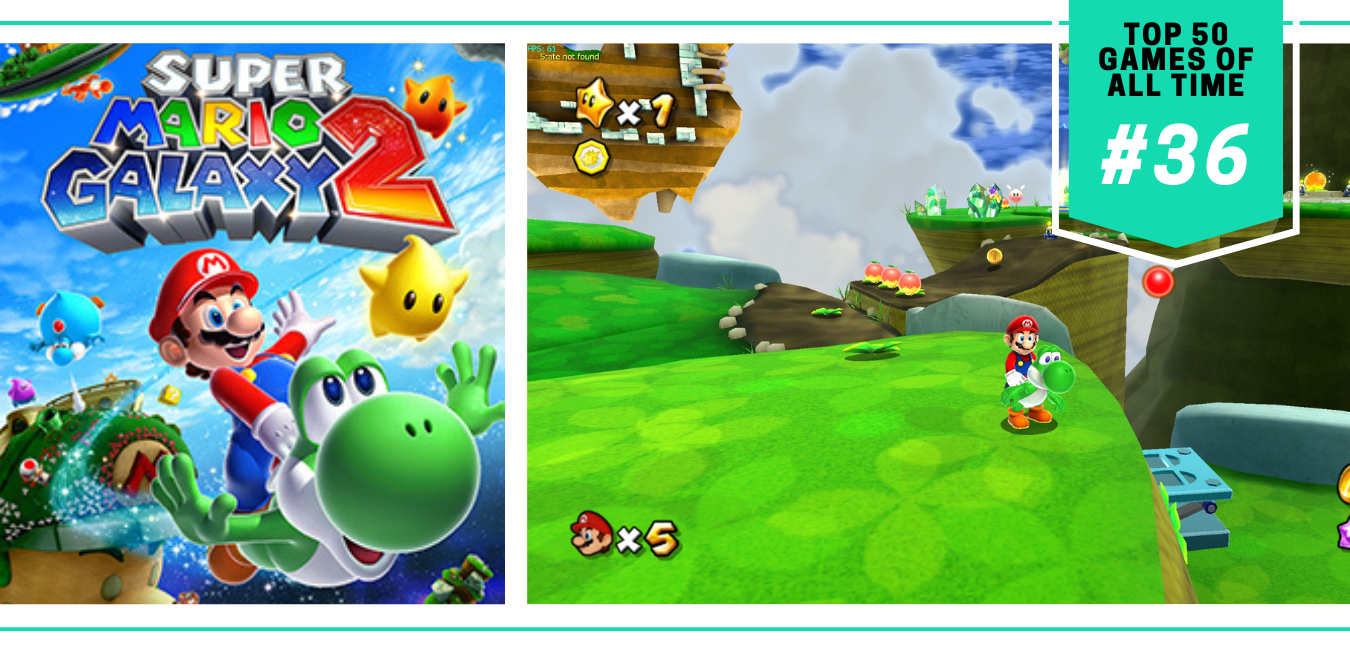
36. Super Mario Galaxy 2
Super Mario Galaxy may have originated our favorite plumber’s planet-spanning shtick, but I would argue that its sequel, Super Mario Galaxy 2, is the far more memorable one.
It’s rare for a video game sequel to exude so much more creativity than its inspiration, yet Super Mario Galaxy 2 delivers. The levels are more intricate, the power-ups are more thrilling, and the ideas are more fully realized. I’m partial to Super Mario Sunshine myself, but if I check my bias, I’ve yet to find a platformer more creative, more ingenious, more fun than this one.
The introduction of Yoshi alone makes this a memorable experience, but Super Mario Galaxy 2 isn’t one to rest on its laurels. From river races to rhythm challenges, pixel-perfect platforming to thrilling boss battles, the brilliant moments come fast and frequently. It’s a shame that Super Mario Odyssey has yet to see a sequel, for based on this game alone, Nintendo would have an all-time hit in its midst.
Super Mario Galaxy 2 was famously said to have originated because Nintendo simply had too many ideas to fit into one game alone. Well, in an industry where sequels are frequent but ingenuity is scarce, SMG2 stands out as an example of how to do a follow-up adventure right.
Platform: Nintendo Wii
– Written by David Silbert
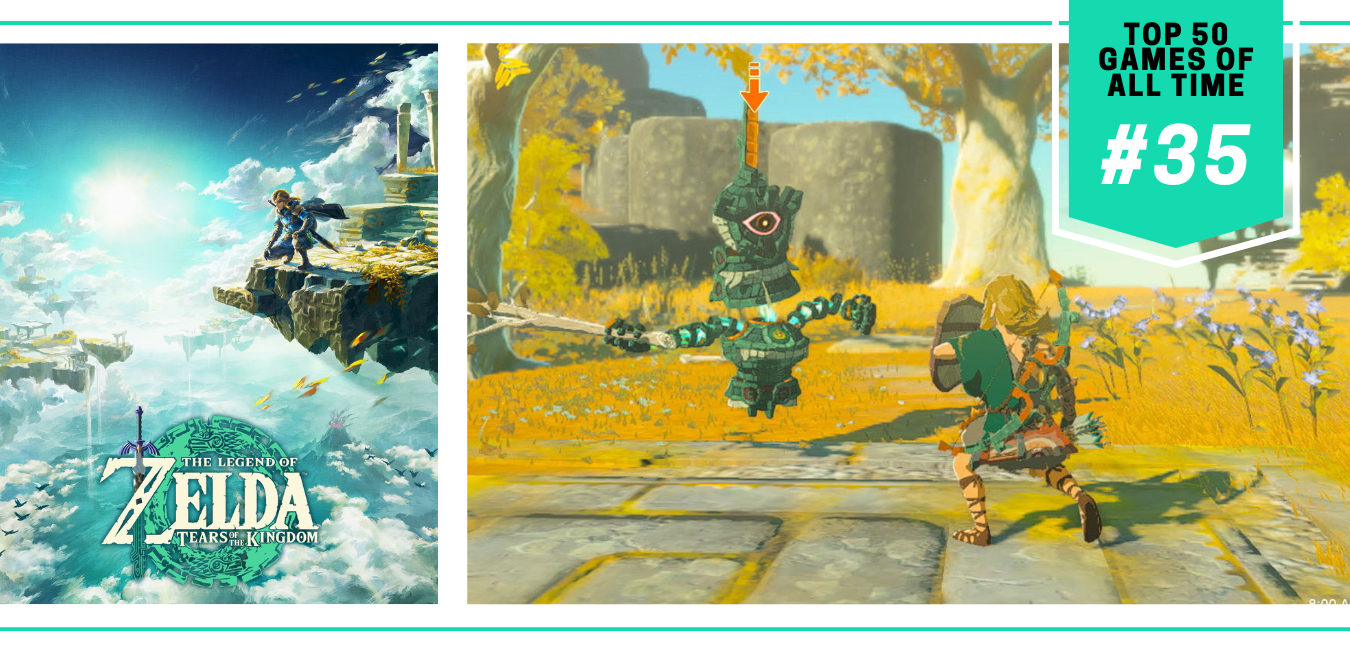
35. The Legend of Zelda: Tears of the Kingdom
Tears of the Kingdom came out during a challenging point in my life. Just days after it was released, I unexpectedly lost my job days before moving into my own apartment for the first time. My world was turned upside down, and I was lost and without any clarity of what was to come. So, of course, the first thing I did in my own home was to set up my new 65” TV, a patio chair, and plug in the ol’ Switch to use my suddenly free time to complete a game that should have taken me months in a matter of weeks. As some would say, that was the ideal male living space.
And boy, did Tears deliver. We all said the same thing going into it: How in the world is Nintendo going to replicate the experience of Breath of the Wild in the exact same map? Just a few minutes in, our questions were answered: a completely new aerial map, a mysterious story we needed to piece together about Hyrule’s history, and, best of all, an entirely new set of toys to play around with that allowed us to create and reinvent the world. The creativity, challenges, and endless solutions to Tears’ puzzles set it apart from its predecessor, standing tall in the ranks of gaming history. It is simply impossible for two playthroughs to be the same, making Tears the perfect distraction from reality to disappear into a Hyrule that is truly their own.
Platforms: Nintendo Switch, Switch 2
– Written by Mark Bowers
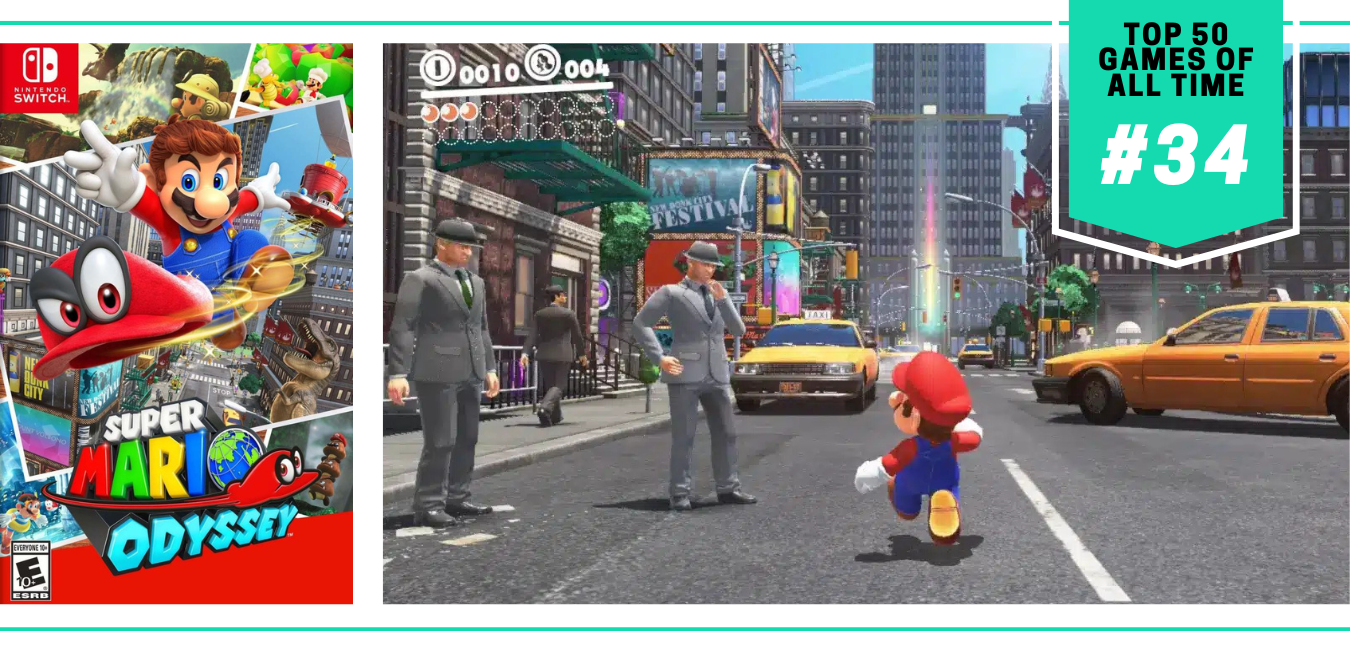
34. Super Mario Odyssey
Simply put, Super Mario Odyssey is a spectacle. The beauty of Mario is that in every new release, you are seeing something that you couldn’t even comprehend not only being done, but being executed at a flawless level. In Odyssey, Mario can be just about anything: a Goomba, a fork, a T-REX. I mean, come on. Find a more fun game. I dare you.
Beyond the characters, though, Odyssey just has so much to offer. Every world is vast, unique, and offers new yet retroactively simple puzzles to find its moons. The moons are everywhere, but each has its own challenge to finding it. Sometimes they are in plain sight, sometimes you have to turn into 8-bit Mario to find them, and other times, you have to hop against traffic up a busy pedestrian walkway to reach it. Everywhere you look, there is something new in this game.
And finally, there is the music. Few games capture the fun and absurdity of their world via music like Mario does, and Odyssey is no exception. From the moment I landed at “Fossil Falls,” I knew I was in for a spectacular adventure, but we all know why we’re really here: “Jump Up, Super Star!” has gone on to be not just the most iconic song in Odyssey, but one of the most legendary in both Super Mario and gaming as a whole. There is nothing more to say really: The level speaks for itself, for Odyssey, and everything Mario is. We are so lucky to get to play this game.
Platform: Nintendo Switch
– Written by Mark Bowers
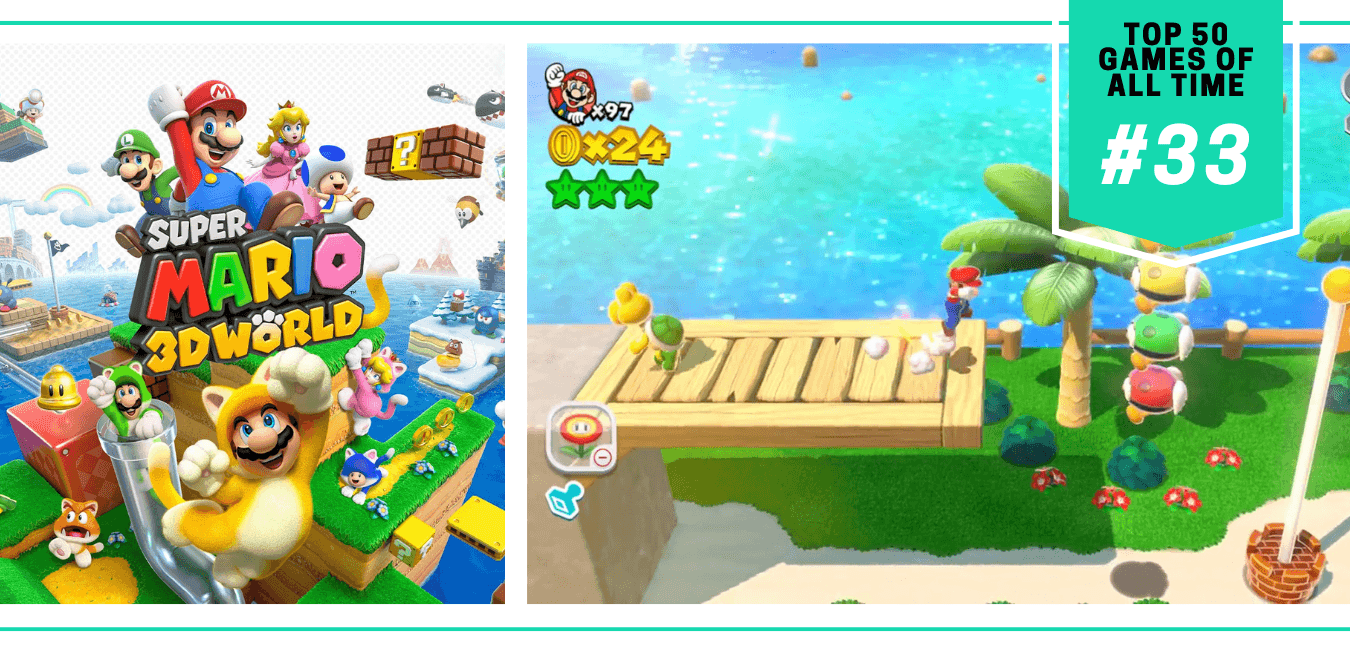
33. Super Mario 3D World
Super Mario 3D World released in 2013 on the Nintendo Wii U and on the Nintendo Switch in 2021. An explorative 3D platformer, the game has you roam colorful levels in several unique worlds. Unlike the New Super Mario Bros. 2D platformers, you can explore new areas in search of stamps and stars. One of my favorite gameplay features is the Cat Mario power-up, which lets you climb walls with ease and scratch enemies with your adorable paws.
Super Mario 3D World also has the perfect level of difficulty. In the beginning, you can quickly move from world to world and reach all your objectives. As the game progresses, the challenge spikes, making you feel the burn when you have to retry the later levels.
This is one of those Mario titles that fills me with joy when I think about it—and it’s one of those games I can replay without feeling bored. 3D World has so much to discover in the world: hidden levels, tricky objectives, and so, so much more. Plus, the couch co-op play is a blast, and especially fun to play with kids. Meanwhile, the best part about the Switch port of 3D World is that it comes with an additional 3D adventure, Bowser’s Fury. Super Mario 3D World is a must-play Nintendo game, and I hope we see more on the Nintendo Switch 2.
Platforms: Nintendo Wii U, Switch
– Written by Allison McDaniel
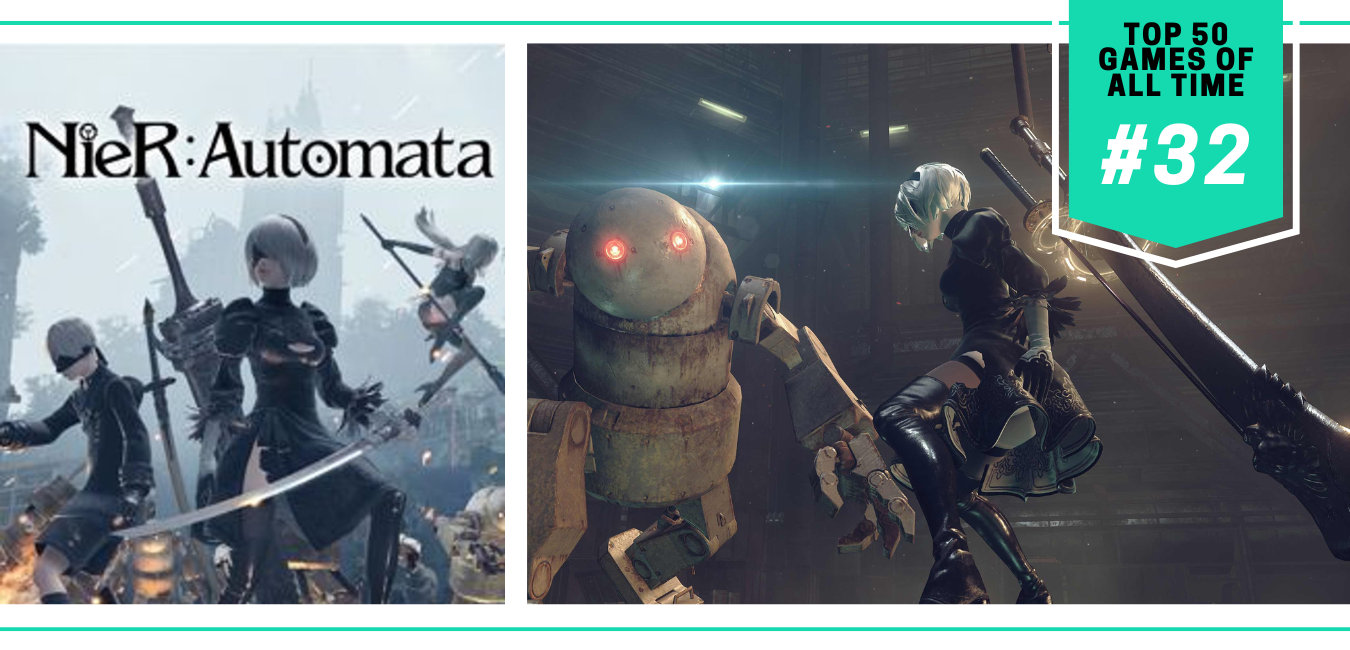
32. Nier: Automata
Nier: Automata truly pushed the boundaries of what I thought games could be. Its tragic-yet-hopeful story, quirky and creative game design, and stunning art direction combined into an experience that has stuck with me ever since. While its hack-and-slash gameplay didn’t necessarily reinvent the wheel, Nier: Automata stood out for its deeply memorable cast and narrative ambition.
The game radiates this haunting feeling of loneliness—something I could relate to profoundly at the time. I first played Nier: Automata fresh out of college, living in a new city, adjusting to a new job, and grappling with my own personal existential crisis. Somehow, this game mirrored my internal struggle perfectly, as its characters—androids and machines alike—wrestled with their own questions of purpose, meaning, and survival.
Everything builds toward an ending that hit me harder than I could have ever anticipated. It genuinely brought me to tears. Nier: Automata didn’t just entertain me—it resonated with me on a personal level. It also introduced me to my eternal waifu, 2B (how could I not mention her?). For its powerful storytelling, unforgettable characters, and its ability to challenge what games can express, Nier: Automata absolutely deserves its spot in our top 50.
Platforms: PlayStation 4, PC, Xbox One, Nintendo Switch
– Written by Donovan Harrell
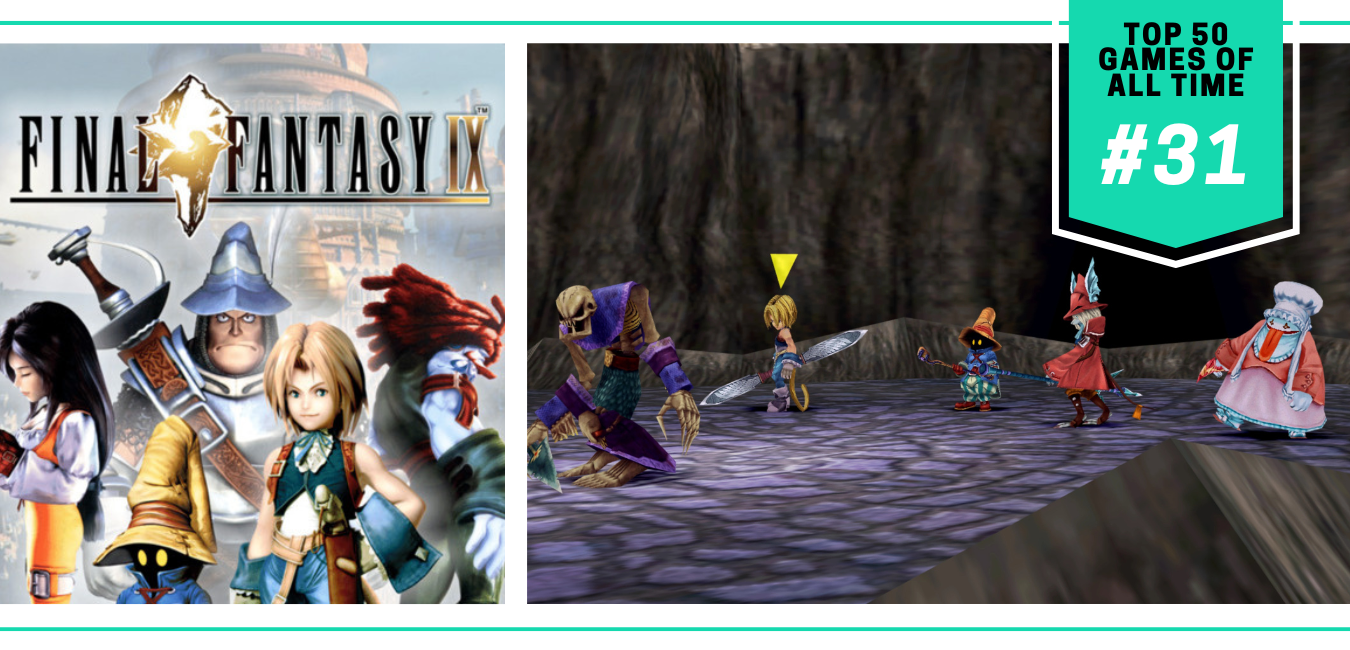
31. Final Fantasy IX
Final Fantasy IX is the only game I’ve ever bought solely because I saw ads for it. Now, it took me about 10 years to make the purchase, but it still counts. After playing about an hour of the game, though I was immediately in love with it, despite acknowledging the difficulty (some of the earliest mandatory battles will have you fighting for your life to beat them).
The plot centers on a lovable group of outcasts (a thief, a knight, a mage, a princess, etc.) in a medieval fantasy setting who come together to save the world. Each character faces personal challenges that they learn to overcome thanks to the support of their new friends, forging their own destinies instead of following the path expected of them.
While this may sound like the premise of any great fantasy story, it’s the execution of such solid principles that makes this game legendary. Somehow, despite watching characters face life changing traumas and shift their entire world views, there’s a constant level of wit, levity, and downright compassion, making these characters all the more lovable.
Thanks to their unique backgrounds, each character brings a different dynamic to combat. This allows a range of different abilities and play styles which keeps the game fresh, while rewarding you for finding the right party combos. One of the most memorable characters is Quina, who at first glance looks ridiculous as their tongue hangs out their mouth almost reaching the ground, and all they can talk about is food. They embody a childlike curiosity, exploring the world through food and confusing others with their genderless appearance.
To understand them, there’s a great moment in the game where they happily explain leftovers are good to the main character, Zidane, despite being picked last for a mission (turns out, they are one of the strongest characters in the game thanks to their Blue Magic). Its seemingly one off moments like these repeated throughout the game which really bring this cast together and make their journey one worth completing.
Platforms: PlayStation, Android, iOS, PC, PlayStation 4, Nintendo Switch, Xbox One
– Written by Vaughn Hunt
Our Top 30 Video Games of All Time
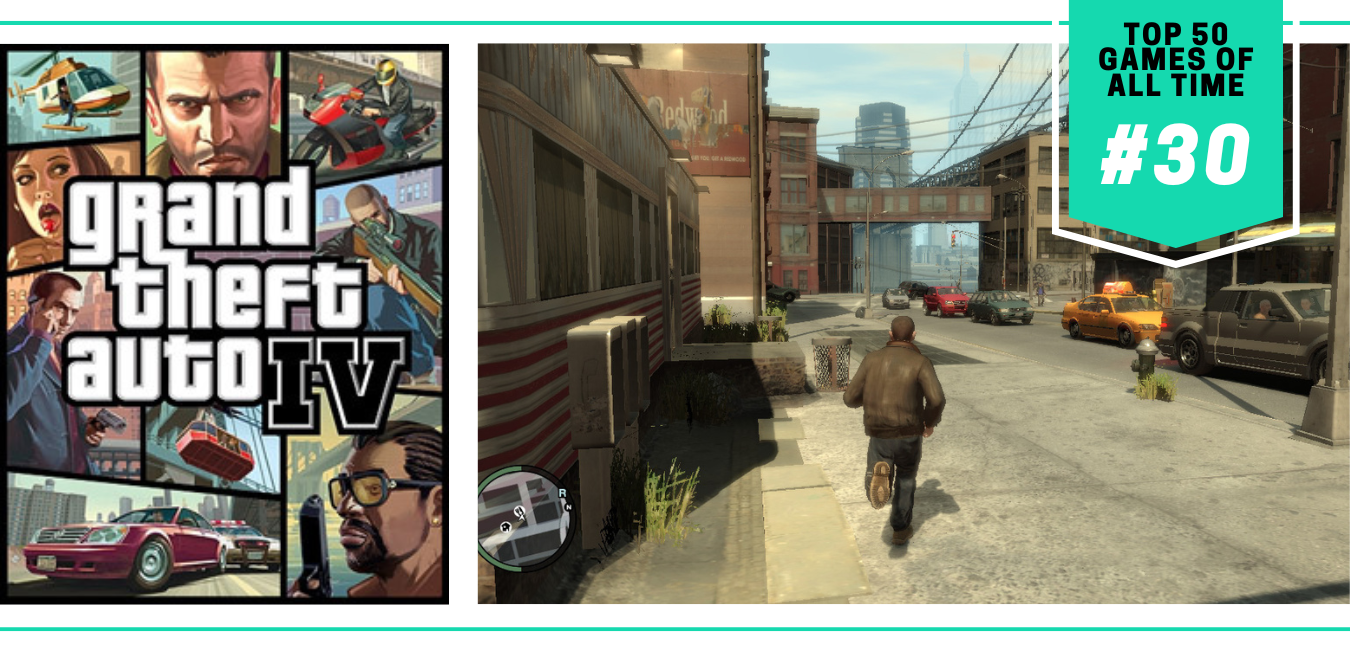
30. Grand Theft Auto IV
Rockstar’s Grand Theft Auto IV seems to be the least beloved in the series. It changed the art style of the PS2-era games (III, Vice City, and San Andreas). More notably, though, it made some of the subtext of the previous games into unignorable context—ripping off a Band-Aid in the post-9/11 U.S. immigration policy and politics in video games.
GTA IV is a brilliantly crafted tapestry that tells the story of Eastern European veteran Niko Bellic. His American story in Liberty City will break your heart. His time in the fictional city is full of thrills, booze, and robberies. Much like the best American novels of the twentieth century, there aren’t many happy endings here. Some days I still just sit to think about the game’s beautifully destructive endings.
I recently restarted it on Steam Deck. It felt like revisiting Polaroids of old friends. These are moments long forgotten, and somehow ephemerally captured against the muted colors of the seventh generation consoles. I miss Niko. Maybe one day we’ll see him again in a Rockstar game.
Platforms: PlayStation 3, Xbox 360, PC
– Written by Clint Morrison, Jr.
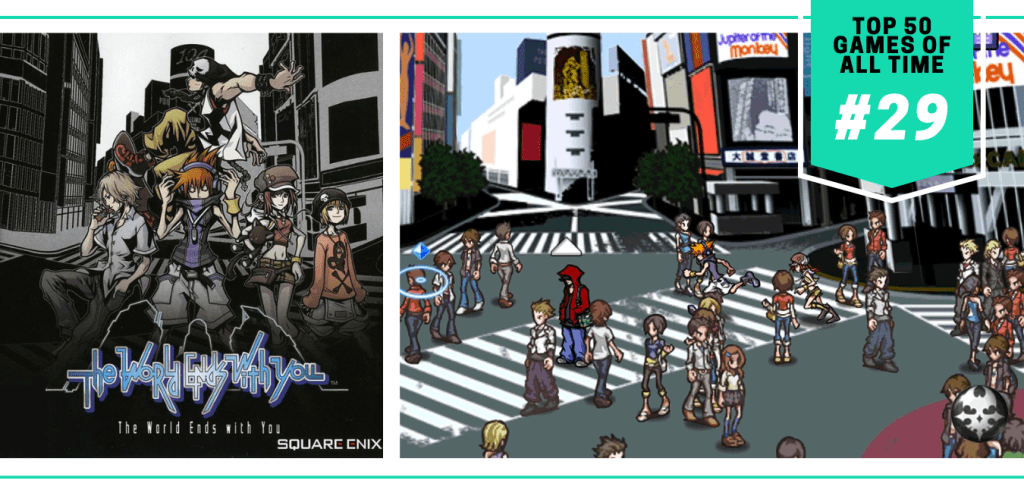
29. The World Ends with You
I wish I could say it was love at first sight with The World Ends with You. I wish I could say that the innovative combat system, bouncing attacks between the top and bottom of my DS screen, made sense right off the jump. But it didn’t. The first time I tried playing TWEWY, I hated it. Wrapping my head around the attack-juggling and paying attention to two different screens at once was beyond me. I was content to leave it as a fun experiment that just wasn’t for me. Luckily, I tried again due to browbeating from friends. I was repeatedly told, “It would click,” “You’ll get it,” “It’s so worth it just to try.” So I said screw it. I’ll try again.
What awaited me remains one of the greatest gaming experiences I’ve ever had. Once my brain clicked with the combat, I found depth and intricacy I have never found again. Slamming Psyches together to create weird combos and elemental explosions was exhilarating; landing a perfect Sync attack brought a feeling of confidence I’ve rarely felt again. And all that pales to the story.
To this very day, few games have touched me the way that TWEWY has. By focusing on a sobering look at the impacts of lonerism, on how teenage self-seclusion can lead to a life yearning for connection, shook the 14-year-old me. Its core ethos—namely, how if you don’t interact with the world at large you will never see joy in it—has stuck with me even now. I needed Neku Sakuraba to grow to show me that I could also grow, that connecting with people is terrifying and hard but worth it in the end. I didn’t want my world to end with me, I wanted to know more. Luckily, I had a guide.
Platforms: Nintendo DS, iOS, Android, Nintendo Switch
– Written by Gary Wilson
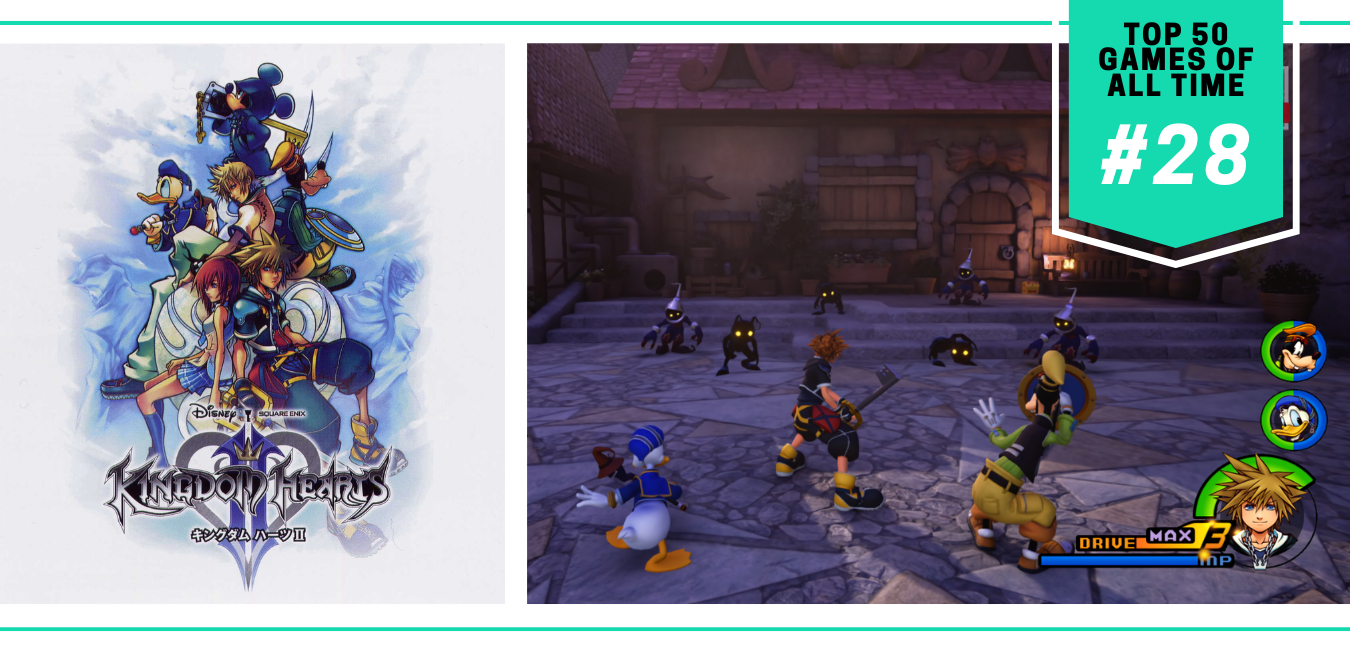
28. Kingdom Hearts II
The original Kingdom Hearts, by many accounts, is the most consequential game in the franchise. It established our dearly beloved trio—Sora, Riku, Kairi—while introducing them to a cast of Final Fantasy legends. Cloud, Leon (aka Squall), Yuffie, and more were given fresh life through a Disney lens. And, of course, Kingdom Hearts gave us Traverse Town, home to the greatest JRPG town theme of all time.
The point is, Kingdom Hearts II had big shoes to fill. And fill them it did! The much-anticipated follow-up introduced players to a new cast of characters—most notably, Roxas, Sora’s nobody. It also expanded on the lore of Organization XIII that was established in Kingdom Hearts: Chain of Memories (a game very near and dear to my heart). Add in new locales (Twilight Town!), new Final Fantasy additions (Vivi!), and a darker, broader story, and Kingdom Hearts II was an all-around terrific sequel.
Perhaps Kingdom Hearts II’s greatest accomplishment, though, was its combat. Building on the original’s terrific battle system, KHII upped the stakes with greater mechanics and grander set pieces. The “Reaction Command” system, which had players tap the triangle button for contextual moves based on the battle or enemy, was particularly clever, ensuring every encounter felt fresh and exciting. Add in iconic moments like scaling a skyscraper in The World That Never Was and, of course, that bonkers final battle, and Kingdom Hearts II solidifies its place as one of the greatest games of all time.
Platforms: PlayStation 2, PlayStation 3, PlayStation 4, Xbox One, PC, Nintendo Switch
– Written by David Silbert
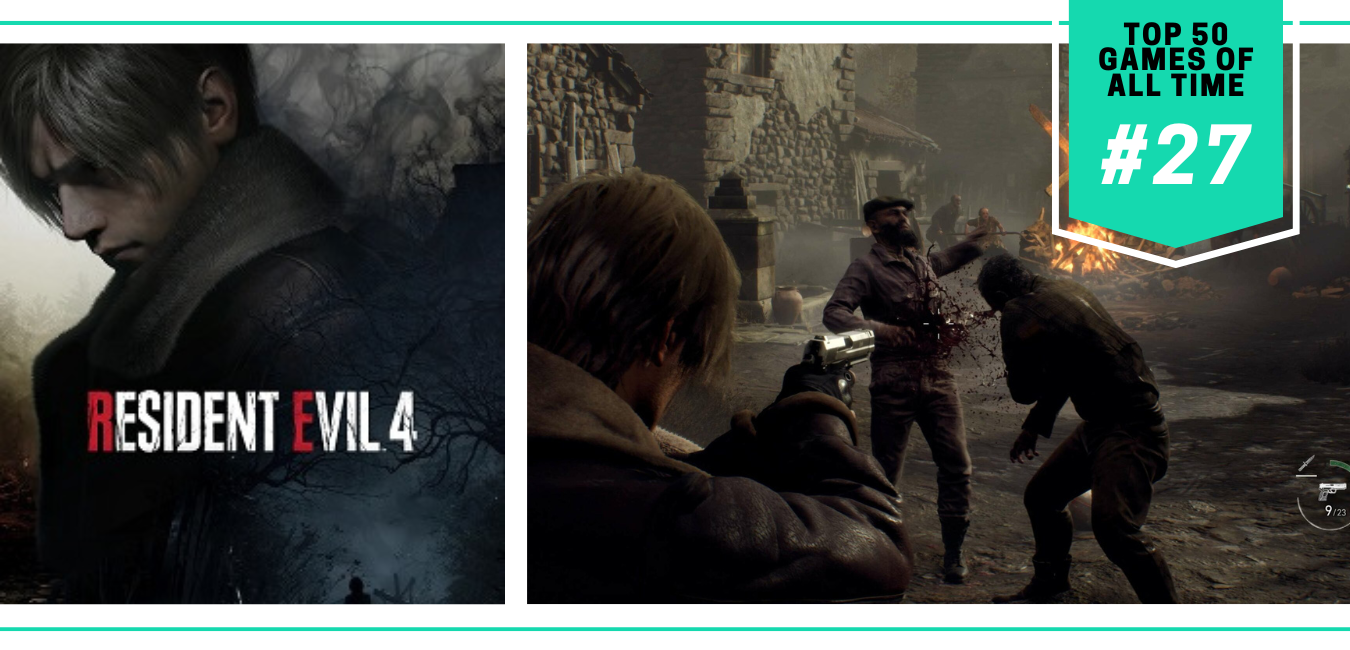
27. Resident Evil 4 (2023)
I know this can be a contentious choice over the original, but Resident Evil 4 is easily my favorite of the recent Resident Evil remakes. It’s the perfect blend of horror and action, with an addictive gameplay loop that had me replaying it over and over. Halfway through my first run, I already couldn’t stop thinking about how excited I was to dive back in for another playthrough.
I’ve played the original Resident Evil 4, and while I absolutely understand why it’s such an influential, genre-defining game that laid the foundation for modern third-person shooters, the remake improves on that formula in every way. From its cinematic story presentation to its tighter, more fluid gameplay, it imports all the charm of the original while adding clever twists and surprises to keep longtime fans on their toes. At the same time, it offers newcomers an explosive, breathtaking experience from start to finish.
While I still love the original, what makes the remake stand above is, without question, the gameplay. The original, as impactful as it was, definitely shows its age. In contrast, the remake’s gunplay feels smooth and perfect. Leon moves with an incredible sense of precision, letting you live out the power fantasy of playing as a John Wick–style action hero. The way he handles his arsenal—dispatching zombies with brutal efficiency and stylish martial arts—never gets old. The knife parry is undeniably satisfying. And the addition of Mercenaries Mode gives me endless reasons to keep coming back for more.
Platforms: PC, PlayStation 4, PlayStation 5, Xbox Series X/S, iOS
– Written by Donovan Harrell

26. God of War (2018)
I didn’t write about God of War Ragnarök for this list, but I think it’s important for me to say this much about it: There is so much about it that improved upon its predecessor that it is nearly impossible for me to speak about one without the other. So why am I writing about the 2018 game instead? Well, there’s one thing in particular that Ragnarök could not surpass, despite its best efforts: heart.
Yes, I’ve heard it all. In fact, I’ve said it all too. Repetitive enemies. Boring bosses. Weak “open world.” They’re all true. But you know what? It doesn’t matter. This game isn’t about the gameplay so much as the journey. We all love mowing down enemies as Kratos, but what God of War does better than just about any other game I’ve played is pour heart into its characters.
Atreus doesn’t understand who he is and is faced with the reality of being a god before he learns what it means, struggling to balance his wonder with the world along with his anger at his upbringing. Baldur wants to be free of the pain (or rather, the lack thereof) that his mother cursed him with; Freya, on the other side, wants to help Atreus, but will stop at nothing to protect her son as he stalks them. And of course, there is Kratos, grappling with his duty as a widowed father and also the secrets of his own past, praying that Atreus does not fall victim to his sins as well.
As they continue on their journey together, their relationship grows, is tested, and finally transitions into not only a father/son dynamic, but a true partnership built on mutual trust and respect. The finale features Kratos making a choice he never wanted to again to save a life that didn’t deserve to end, all the while knowing that he will not be forgiven for it, but also using it to show Atreus how they must strive every day to be better than the Gods that came before them, himself included. All of this leads to an absolutely gorgeous moment where the two say goodbye to their wife and mother for the last time, standing together solemnly as not just gods, not a father and son, but as equals, preparing for what battles are inevitably to come.
Platforms: PlayStation 4, PlayStation 5, PC
– Written by Mark Bowers
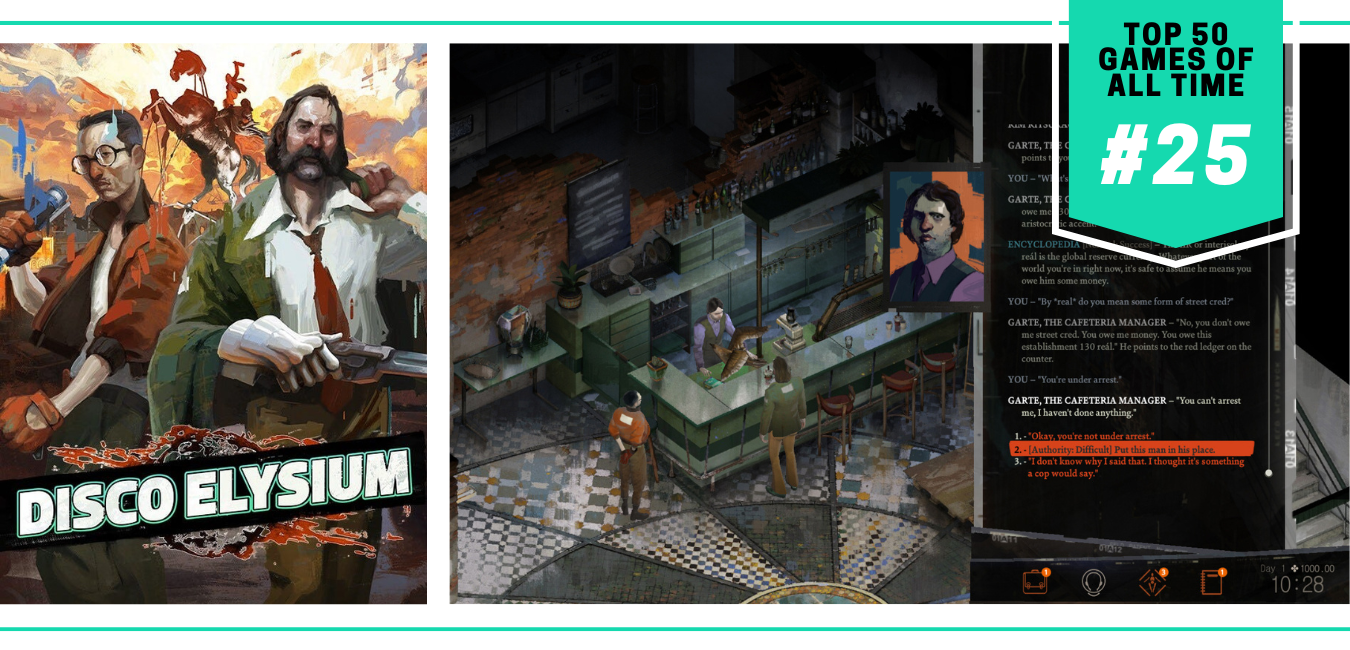
25. Disco Elysium
Disco Elysium didn’t have to be the well-crafted RPG that it became. The drama that unfolded between ZA/UM and developers, in addition to the recent crop of games “from the developers of Disco Elysium,” indicate that this carefully crafted masterpiece may have been more of an accidental miracle. As a result, Harry and Kim’s detective RPG in Revachol feels like a dream that we all collectively imagined.
I love the watercolor expressionism of Disco Elysium as a conduit for its ideas. Many of the political and literary theories that informed much of my own reading lists inspired the world and dialogue trees of the game. I remember telling one of my literary theory professors in graduate school that he should play this game (he did not, and honestly, I still think he missed out).
What has always captured my attention about Disco Elysium is how little either of its main characters matter. The most excitement of Revachol happened nearly 50 years prior to Harry waking up hungover and nearly naked in his hostel room. In nearly any other RPG, the story would take place there, or our protagonist would be a second coming of sorts. Instead, Disco Elysium only ever allows the player, protagonist, and Kim to be outsiders peering in—to always be observed and suspect as they investigate a murder case themselves.
Platforms: PC, Mac, PlayStation 4, PlayStation 5, Nintendo Switch, Xbox One, Xbox Series X/S, Android
– Written by Clint Morrison, Jr.
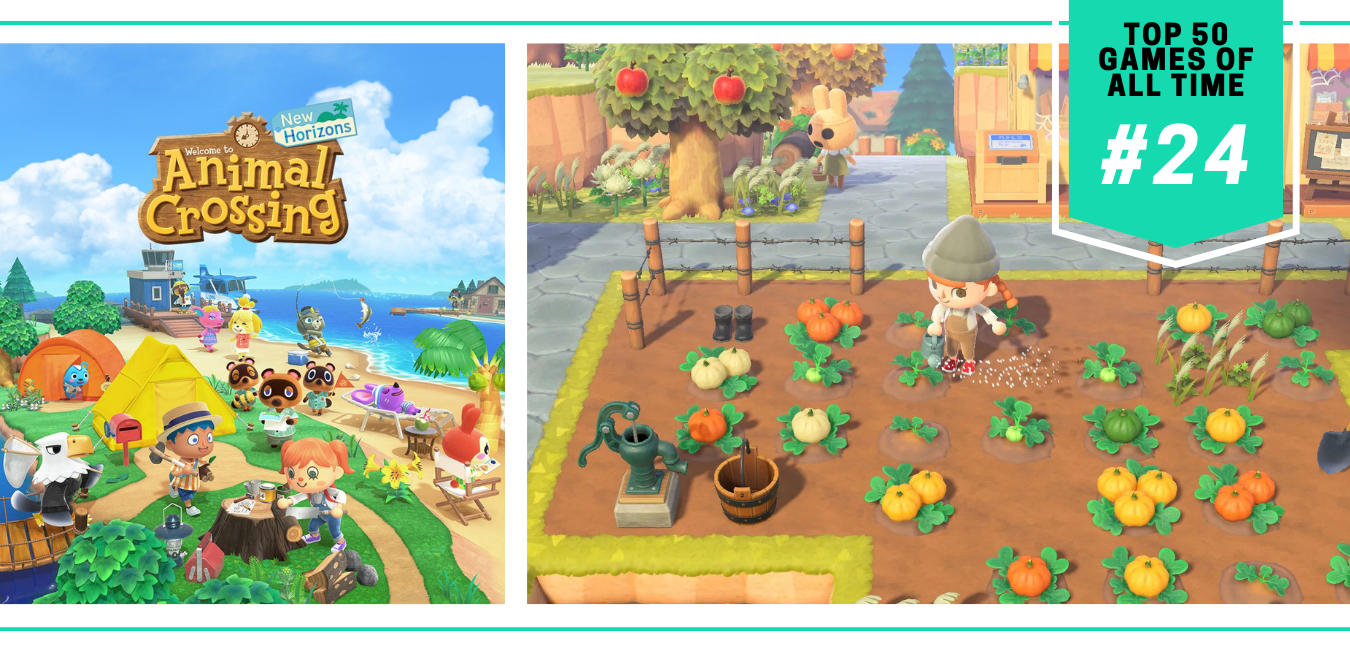
24. Animal Crossing: New Horizons
As far as I can tell, Animal Crossing: New Horizons is the only game ever made that was so popular it raised conspiracy theories about whether or not Nintendo created a global pandemic just to encourage people to stay inside and play it. The latest installment in the long-running series was released on March 20th, 2020 which was, for many of us, the first week of a mandated lockdown we didn’t know would last for months.
To say that Nintendo capitalized on the opportunity to sell an idealized version of reality where you live on a tropical island surrounded by cute animals instead of being trapped in your home terrified to leave for fear of catching a deadly disease would be an understatement. As of April 2025, Animal Crossing: New Horizons is the 15th highest selling video game of all time. Thanks, coronavirus!
We’ll never know if the game would have been as popular had it not been for COVID-19, but the fact is it remains my most played Nintendo Switch game by more than double the hours of second place. Both my wife and I have hundreds upon hundreds of hours in Animal Crossing and therein lies the beauty of it. The best part about being on your own perfectly manicured island is that you’re not spending time in your real life, and I’d take any excuse just to be back there.
You can do all kinds of things in this game, but it all boils down to reveling in the escapism. Sure, there’s some goals and objectives like getting the biggest house possible or filling your island with rare animals. But some of the most fun I had was collecting fruit from trees or decorating my lawn or finding just the right outfit. I can’t help but smile when I even think about the theme playing as I boot up my island or hearing the daily announcements from Isabelle.
There’s such a sense of calm that washes over you when you play Animal Crossing: New Horizons and its ability to transport you out of your head is a special trait. It really is like getting a warm hug, just make sure you’re wearing a mask when you get that close.
Platform: Nintendo Switch
– Written by Zack Gulinello

23. Persona 3
Persona 3 was my first foray into Atlus’ long-running series. The game, released stateside in 2007, followed a group of high-school eccentrics as they ascended a bloodstained tower known as Tartarus. Along the way, they battled dangerous creatures, built bonds with one another, and protected the world against the embodiment of death itself. It was dark. It was depressing. It was one of the greatest games I’d ever played.
Part of the allure of the Persona games is how it weaves Jungian psychology into the fabric of a slice-of-life RPG. At night, your character calls upon Pokémon-esque personas—presented as various facades within your psyche—to battle against the collective unconscious known as Shadows. During the day, you attend school, hang out with friends, go on dates, and more—all while building Social Links that enable you to unlock more complex and powerful personas.
In essence, Persona embodies the game of life. And though Persona 4 and Persona 5 would add some crucial gameplay elements—playable party members, hand-crafted dungeons, expanded nighttime exploration—it’s the story of Persona 3 that will always stay with me. This is a game with no easy roads and no magic ending. Some people live; others die. Some betray you; others love you. You can’t save everyone, but you can do your best to live out your values every single day—and trust that your friends will have your back.
If you missed the boat on PS2, Persona 3 has several other on-ramps, including its wildly streamlined Portable version (complete with femme MC) and its recent one-to-one remake, Persona 3 Reload. All versions of the game are excellent, but I’ll always cherish the very first.
Platforms: PlayStation 2, PlayStation Portable, PC, PlayStation 4, Xbox One, Nintendo Switch, PlayStation 5, Xbox Series X/S
– Written by David Silbert
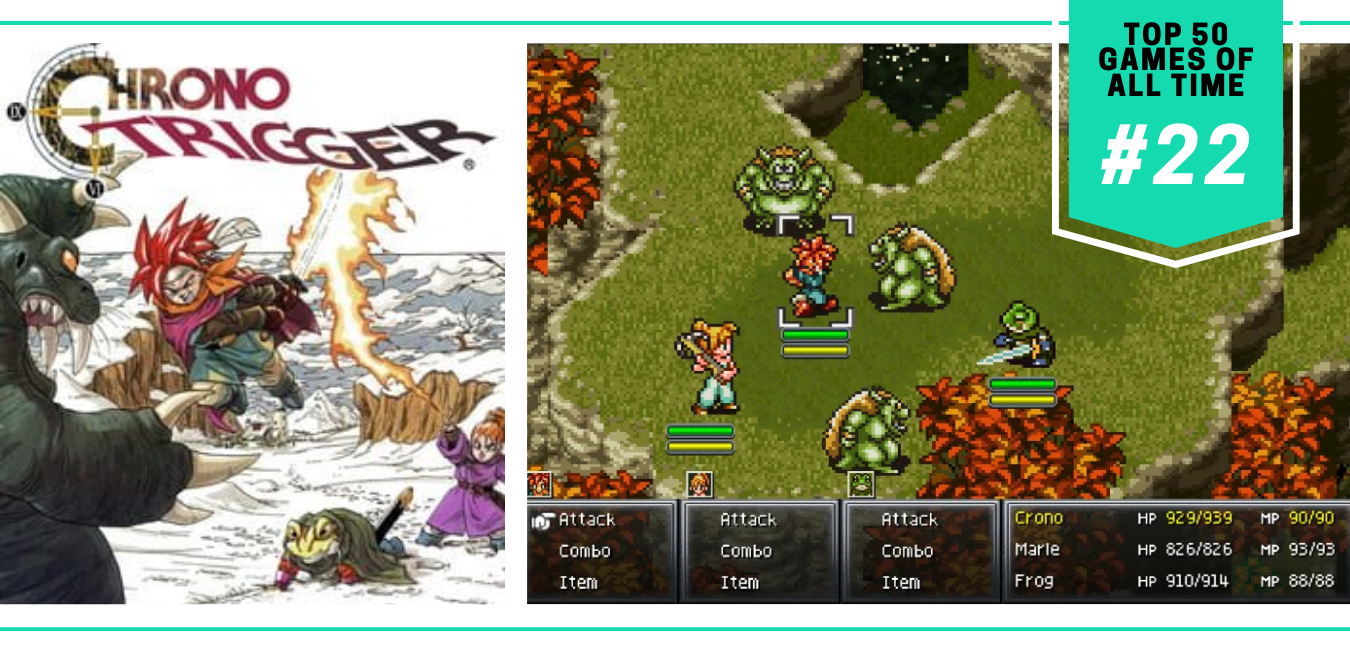
22. Chrono Trigger
If you were to ask me what Chrono Trigger was about—not in the sense of describing the plot or mechanics, but rather the core of what the game is trying to accomplish—I’d say it’s about the idea that every single moment matters, and that very notion is essential to the survival of any and every populus that exists, has ever existed, or will ever exist. The first collaboration between Square and Enix before the two companies merged, Chrono Trigger dared to ask, “How would it feel knowing you could see the results of small decisions hundreds of years into the future, or know you could radically alter the present by changing something seemingly miniscule thousands of years in the past?”
Since its release in 1995, players and critics alike have consistently cited Chrono Trigger as one of the most important games of its era and one of the best RPGs ever made. Its inclusion on this particular list, given the kinds of people that write here, is no surprise at all. The turn-based combat mechanics (including a lack of random encounters) are consistently engaging and flashy. The visuals are simultaneously gorgeous and haunting. The soundtrack—my goodness, the soundtrack—contains some of the most iconic video game compositions of the ’90s, with an incredible balance of inspiring anthems and solemn ballads. The plot itself isn’t exactly the most memorable on its own, but the way the game tells its story with incredible characters, sharp writing (shout out to the GOD Yuji Horii), and striking environmental design makes it one of the most narratively satisfying experiences on the Super Nintendo.
So, we know Chrono Trigger is great and—more importantly—profound and meaningful. But why is it still equally notable today as it was decades ago? The answer is simple: Its message that everything matters remains essential as the world around us grows more cynical and nihilistic. We get more detached from each other, and Chrono Trigger is there to remind us that the bonds we create are more important than anything else. We approach feelings of doomerism and despair, and Chrono Trigger tells us that our actions can still be helpful in the long run. We feel encroaching darkness more than ever, and Chrono Trigger implores us to use whatever light we can find to create a better world.
Platforms: Super Nintendo, PlayStation, Nintendo DS, iOS, Android, PC, Mac, Apple TV
– Written by Sam Martinelli
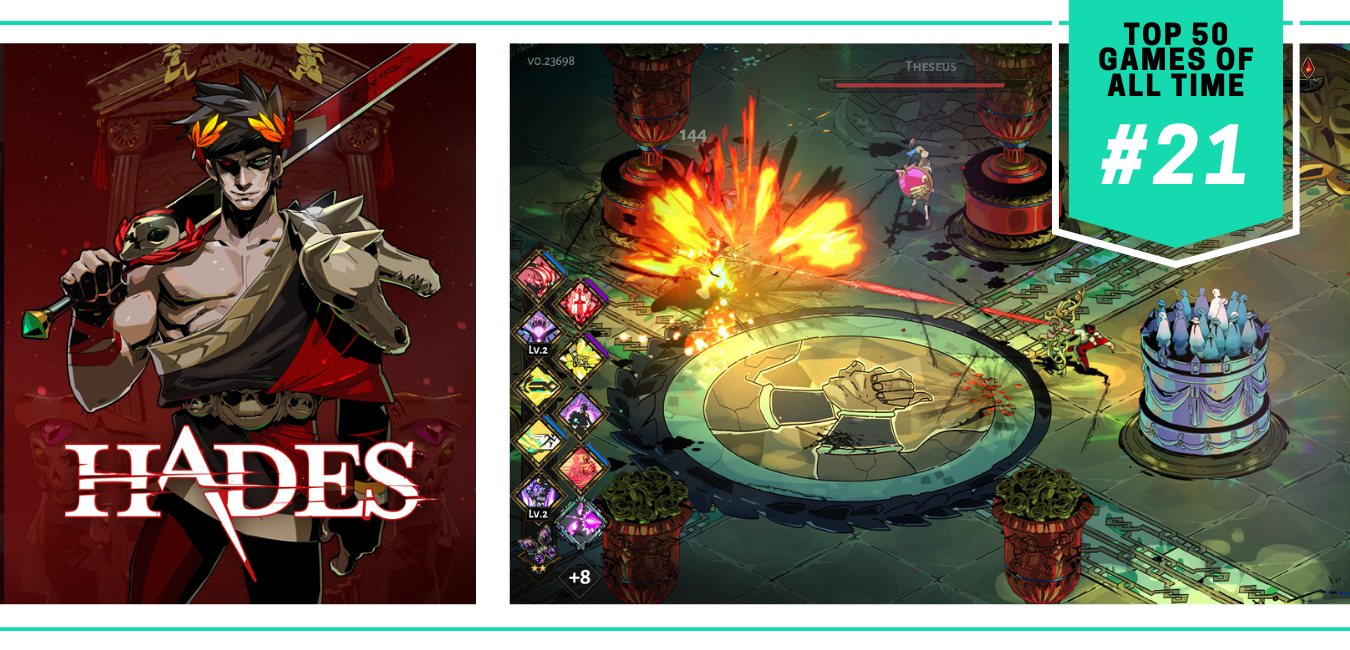
21. Hades
Since I started writing for The Punished Backlog about four years ago, more and more acquaintances have felt comfortable admitting to me, as if it’s sort of a secret (which is wild to me since I feel like it’s much more socially acceptable to be into gaming now), that they like video games, too. When I ask about their favorite games, they hem and haw and say a bunch of normie stuff like Fortnite, Mario Kart, and Call of Duty. I nod along politely until they say Hades.
Hades reminds me of Balatro in that it’s one of those games that has successfully impressed both casual and serious games, which I think makes it worthy of its outstanding legacy. And it makes sense why: Hades is phenomenal. The gameplay is rhythmic, entrancing players in a constant, evolving loop. The art style is stunning. The soundscape is impeccable, from satisfying combat noises to on-point voice acting to exciting music.
As a roguelike, Hades is meant to be replayed over, and over, and over again. It caught gaming society at just the right time, too, coming out in 2020. People felt trapped in routines during the COVID-19 pandemic, and Hades replicated those feelings but added the feeling that evolution was possible. Furthermore, Hades showcased a style of body diversity and inclusivity that made everyone feel they could be a part of Greek mythology.
Supergiant had made other great titles before (including Bastion earlier on this list), but Hades cemented it as an indie darling. Supergiant shared that in the first two years of its release, Hades sold over a million copies across many platforms. That number’s surely grown by now, and it’s all leading up to rabid enthusiasm over the upcoming Hades II sequel.
Platforms: PC, Mac, Nintendo Switch, PlayStation 4, PlayStation 5, Xbox One, Xbox Series X/S, iOS
– Written by Amanda Tien
Our Top 20 Video Games of All Time
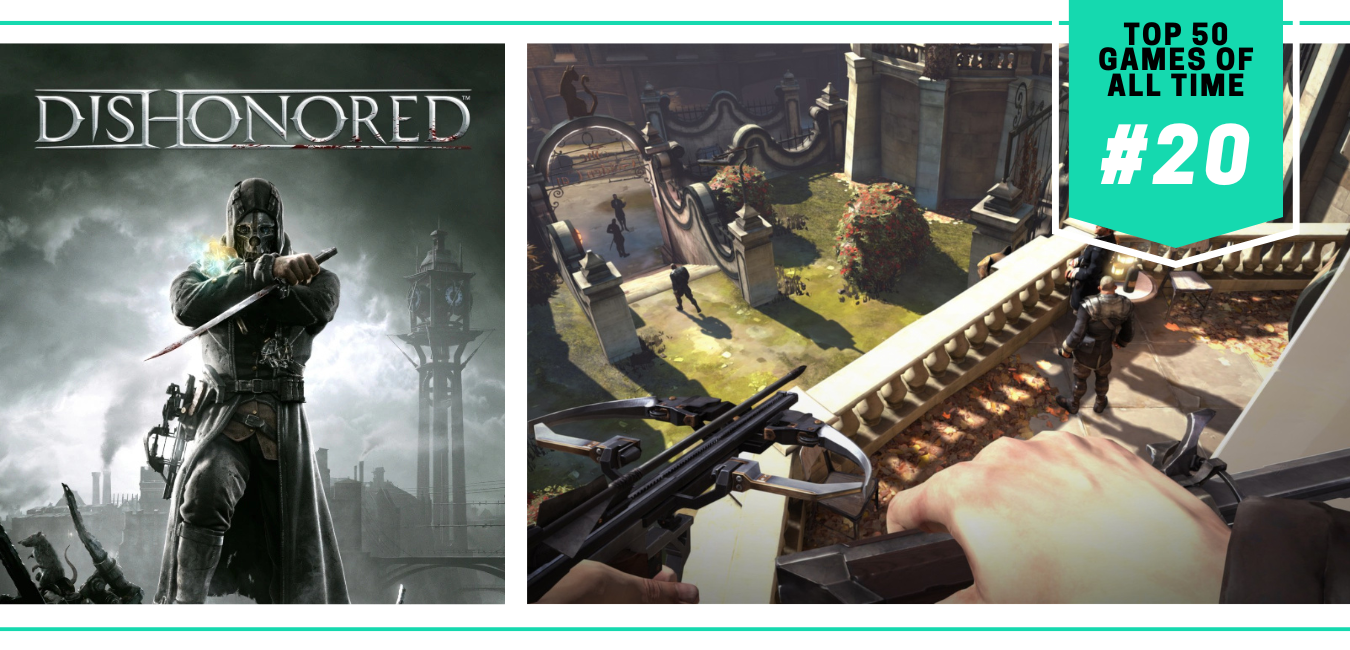
20. Dishonored
Whenever anyone asks me for a game to try, I say, “Have you ever played Dishonored?”
I love this game so much that I often have a hard time even thinking of how to communicate why people should play it. I try to articulate how the gameplay is both sneaky and electrifying, how the world is spooky but not scary, how the world is dark but also full of hope.
A few years ago, I replayed the game in the series—Dishonored, Dishonored 2, and a third not-sequel called Dishonored: Death of the Outsider that’s essentially a mega-DLC—and found them to still be as magical over a decade later. The sequel has some of the best level designs in gaming, so much so that it’s been lauded several times in lists by experts in the industry. And I don’t disagree. But what I think the first Dishonored has going for it that makes it so high on my personal list is the story.
Dishonored follows a man named Corvo Attano who has, as you guessed, been dishonored. He’s a royal bodyguard who is framed for killing his beloved queen and kidnapping her daughter. He must break out of prison to not only clear his name and rescue the princess, but to save his city from a hostile takeover. Everything is on the line for Corvo, and as a player, you feel that in every single beat.
After my replays in 2023, I wrote an essay about why Arkane’s 2012 original is (still) so good, and retrospectively turned it into an entrant for our Punished Hall of Fame. If someone tells me they tried Dishonored and didn’t like it, I instantly think less of them as a person. They clearly weren’t paying attention. Corvo’s movements, fueled by fantastical, otherworldly powers, are sublime. The world-building is detailed, precise, entrancing. The levels feel both focused and expansive, luring you deeper. How could anyone try these games and not think they’re nothing short of perfection?
Hey, by the way, have you ever played Dishonored?
Platforms: PC, PlayStation 3, Xbox 360, PlayStation 4, Xbox One
– Written by Amanda Tien

19. God of War Ragnarök
As Punished Backlog editor Sam Martinelli and I have discussed, this title actually earns many of the moments God of War (2018) got praised for; the close development of parent and child relationship, their complex relationships with other characters and their world, and moral dilemmas in which they often find themselves.
God of War (2018) is an excellent game, but the results of the huge genre shift for the series really start to pay off in its sequel. In Ragnarök, Atreus truly discovers the responsibilities of godhood and the power that comes with divinity. He’s also not alone in his contemplation of the quandaries of godly responsibility as Kratos contemplates what it means to be a God of war, Freya revisits her complicated relationship with Vanheim, and Brok and Sindri reveal more of their storied past. Of course, Mimir has many more living histories to color your journey through the world. Naturally, he is no stranger to the central themes in this entry.
Ultimately, God of War Ragnarök is a story of bonds, vulnerability, and trust. How do you decide who is friend or foe? And how do you convince others you’re right? In this tale, we see our characters struggle with the most intricate parts of themselves as they wrestle the tangled fate of these questions.
The combat is deep, building on the previous mechanics while adding new features and rewarding the mastery of each skill. Meanwhile, the enemies are stronger with greater variation (a small complaint made about the last title), challenging you to mix and match strategies to crush them. And, the gravity of the story is felt throughout the realms, of which you can travel to them all.
God of War Ragnarök wraps up the epic series beautifully, offering conclusions to each of the characters that feel right for their respective journeys. Even the generously free roguelike DLC released a year after the game’s initial release adds a refining touch to this story, feeling like a love letter to fans of the series and showcasing the keen intentionality that’s driven the last two titles.
I laughed, I cried, and I roared in triumph in only the 2nd game I’ve ever platinumed on PlayStation (it’s not hard to guess what the first was). Each step of Kratos’ epic journey is honored in this finale, and it’s deeply moving and cathartic to see our hero learn to be better.
Platforms: PC, PlayStation 4, PlayStation 5
– Written by Vaughn Hunt

18. Sekiro: Shadows Die Twice
It’s no exaggeration to say that FromSoftware changed gaming when they released Dark Souls (or Demon’s Souls, if you prefer). Whether you think they redefined, unearthed, or created a new genre is a matter of personal taste, but their mark on the legacy of the format is undeniable. But if Dark Souls defined one era of FromSoftware, then Sekiro: Shadows Die Twice ushered in another.
Parrying has existed in some form in games for decades, but Sekiro reintroduced it into the greater gaming consciousness as a central mechanic with aplomb. Since its release, we’ve gone from “Souls-like” to “Sekiro-like” as a descriptor, a term for games that focus on deflecting enemy blows and reducing their posture as the form of primary challenge.
Talk of legacy is all well and good, but Sekiro is more than the path it paved for its imitators. It still stands at the apex for games of its kind. The title represented a number of firsts for FromSoftware’s Souls era: a setting that firmly set the game in a place time analogous to real-world history, a non-mute protagonist that spoke and interacted with characters consciously, and the presentation of a linear and clearly presented story, as opposed to the drip-feed of lore and information that is regularly digested by players in the form of video essays.
On the gameplay side, Sekiro was the first Souls game to delve deeply into vertical traversal with Wolf’s grappling hook, and the game diverged from its RPG roots, constricting buildcraft potential in favor player growth. While the “git gud” mentality always surrounded the Souls games (for better or worse), Sekiro leaned into it more than FromSoftware ever had before. If Dark Souls is about challenge, then Sekiro is about mastery, and the exhilaration and thrill of success in Sekiro comes with it a feeling of “earned-ness” that few games have ever been able to replicate.
Platforms: PC, PlayStation 4, Xbox One
– Written by Keisuke Isobe

17. Final Fantasy VII
A curious thing about writing a retrospective on Final Fantasy VII in this specific moment is that so much of its legacy hangs in the balance, the albatross of the Remake trilogy hanging above it like the sword of Damo—rather, like Masamune above Aerith in the Forgotten Temple. The legacy of the original game is, of course, unparalleled and has been dissected and discussed ad infinitum, but it feels impossible to discuss the original without also discussing the remake.
Final Fantasy VII is in some ways a game that is more shaped by the idea of Final Fantasy VII than the game itself. Aerith’s death stands out as a watershed moment in gaming history, but it’s also a moment that comes 10 hours into a 40+ hour game: The most important moments of VII come not in her death but in the developments that follow. Currently, two games into the Remake trilogy, we stand at that moment—in the moments following Aerith’s death, a mystery of fractured worlds, or timelines, or minds, that might lead us to a whole new world—or simply another re-reckoning of tragedy.
On its own merits, VII is revered for its storytelling—and at the time cutting edge visual presentation—more than its gameplay, which in modern times comes across as, well, standard PS1 RPG fare. The materia system is a fun customization and buildcraft outlet, but VII is not particularly well-balanced and the combat is not intensely engaging. That said, it’s chock-full of watershed moments: from the comical (Cloud going snowboarding moments after laying Aerith’s body to rest) to the absurd (Tifa and Scarlet slap-fighting atop a massive cannon) to the intensely emotional (Tifa and Cloud’s journey through the Lifestream, covering his most intimate and buried secrets). There’s a reason it engenders so much discussion, fervor, and love, and I can only hope that whatever final installment of the trilogy that is upcoming can do it all justice.
Platforms: PlayStation, PC, iOS, PlayStation 4, Android, Nintendo Switch, Xbox One
– Written by Keisuke Isobe

16. Baldur’s Gate 3
Dungeons and Dragons has defined tabletop gaming for over 50 years. It’s shaped expectations around dice, rulesets, combat, world-building, and player dynamics. Every TTRPG is responding, in some way, to the legacy of D&D.
In many ways, BioWare’s 1998 Baldur’s Gate and its 2000 sequel—had a similar impact on its medium’s roleplaying. BioWare’s approach to branching side quests, complex relationship-building with party members, and luscious romance influenced hit games that came after, like Bethesda’s Skyrim and CD Projekt Red’s The Witcher 3.
When Larian Studios took on the Baldur’s Gate property after more than 20 years since the last true Baldur’s Gate, there was a lot of trepidation. Some people thought the game would just look like a reskinned version of their previous Pillars of Eternity titles. Others figured there’d be no way they could live up to the shadow before them.
Then, Larian proved everyone wrong.
Baldur’s Gate 3 became a worldwide phenomenon. It won Game of the Year. Since its release in 2023, it has sold over 15 million copies, which is also impressive as it’s truly a modern era title. Baldur’s Gate 3’s influence strayed beyond its player base, too. There was overlap with the book TikTok community. The game’s success brought in more renewed interest to D&D, causing property owners Wizards of the Coast to consistently fumble. Baldur’s Gate 3 is so beloved that someone bothered to recreate and mod it into Stardew Valley, the cozy farm game that has very little in common with the fantasy world-domination fighter.
Influence aside, Baldur’s Gate 3 is worthy of its high place on this list also because it’s a phenomenal video game. It transposes much of the complexities of D&D into a fun, interesting, compelling, powerful video game. Characters are beloved. The world is deep. I talked about it for three hours with Ben, Kei (who also reviewed it), and Joe on The Punished Podcast. Baldur’s Gate 3 is one of the most pitch-perfect examples of a “roleplaying game” that I’ve ever played, and I feel truly honored to have blurbed it.
Platforms: PC, PlayStation 5, Mac, Xbox Series X/S
– Written by Amanda Tien
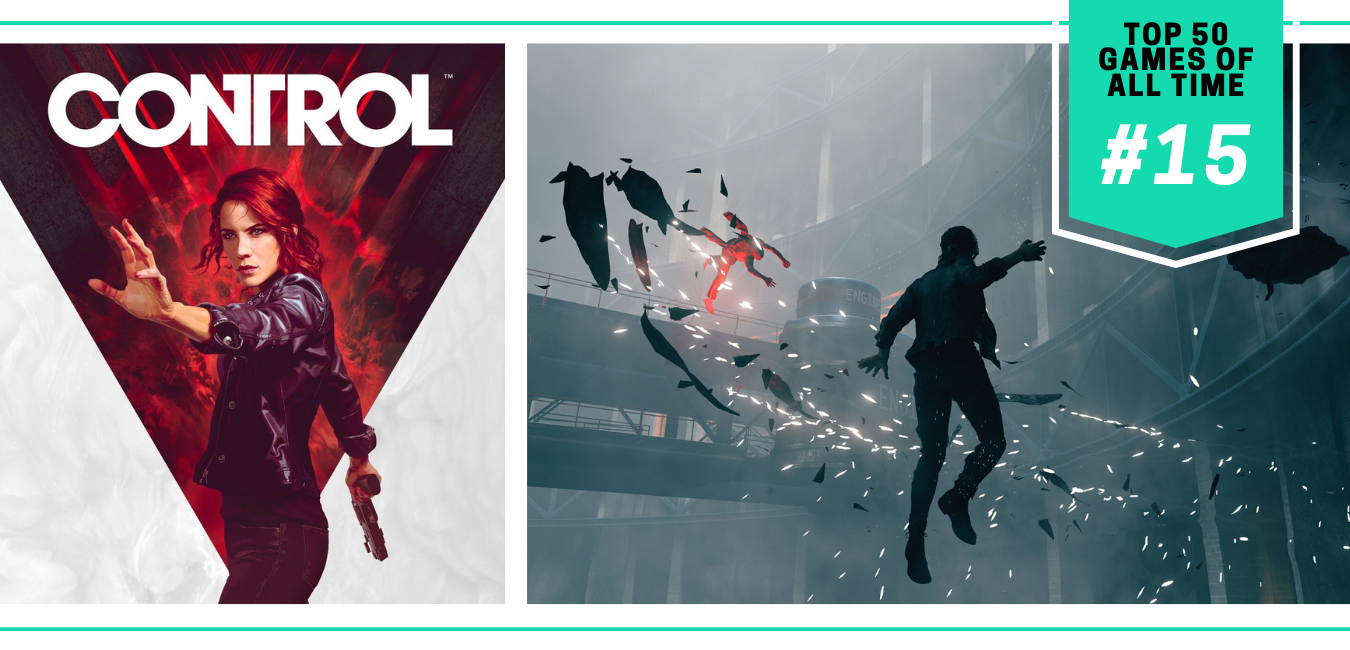
15. Control
Control might have been forgotten in any other year other than 2019.
It was the year before the new consoles arrived. Remedy released a strange trailer for the game during Sony’s 2018 E3 presentation. The Oldest House has captivated my imagination and never let go.
Control is Remedy’s current masterpiece (I like Alan Wake 2; I love Control). Jesse Faden’s opening hours in the Oldest House and origin story in Ordinary are burned into my brain. The atmosphere from visual aesthetic to sound design simultaneously feel part-Twlight Zone and part–Lynchian dream wrapped in a Brutalist and bureaucratic setting that also feels straight out of Jeff VanderMeer’s Authority (the second Southern Reach novel).
The two DLCs for Control really showcased the weird ways that Remedy was willing to build off of the game’s success and allow it to leak into its other properties, namely Alan Wake. Control was after all the first game in the studio’s connected universe that feels more like connected dreams than full-fledged sequels. I mean that as a complimentary antithesis to certain cinematic universes.
It is a weird third-person supernatural shooter with Metroidvania elements that by no means is everyone’s cup of tea but should be celebrated as the most dangerous and experimental title in our top 15. Jesse is one of the best characters from the eighth-generation console cycle, and her first foray as the director of the FBC is not only memorable but unforgettable.
Platforms: PC, PlayStation 4, Xbox One, Luna, Nintendo Switch, PlayStation 5, Xbox Series X/S, MacOS
– Written by Clint Morrison, Jr.

14. Elden Ring
Arguably the most ambitious and grandiose title on this list, FromSoftware was deep in their bag when they developed this game. It’s the culmination of all of their previous Soulborne efforts synthesized into an expansive adventure with a lore rich enough to rival any fantasy series on the market.
There’s something magnificent about this title that the scars of the world’s past are on full display in its current state. I didn’t notice this until starting my second playthrough, but understanding the story helps you trace things from enemy placement, map layout, and even access to items. Even more impressive is how this all comes together to set expectations for combat pacing, difficulty, and the way quests collide with your exploration (a hallmark of Soulsborne games).
The development methodology of this title is to explore the world. It teaches you everything you need to know and the way this is woven back into the player experience is expertly done. If during the first playthrough you’re bewildered and blown away by the sheer terror, wonder, and excitement, then your second playthrough is paced to be one of admiration and awe.
Each aspect of this game builds the atmosphere, from the text choice (“Mantinia” for those searching for it), to the sound design—which the in-game sound effects play off perfectly against the carefully crafted and masterfully executed score—down to the combat loop, which quickly swings from exceedingly satisfying to painfully overwhelming.
The environmental design is also gorgeous; from the golden light of the Erdtree shining over the world, to the wondrous expanse that is Liurnia of the Lakes, to the underground starry skies of the river basins, Elden Ring delivers a world you can lose yourself in wherever you go. Thus far, it’s an easy choice as FromSoftware’s magnum opus, and a testament to mastering the development tools they’ve dazzled us with over the years.
People often complain that the Soulsborne games are too difficult, yet somehow this game delivers the most approachable experience, slowly but “gracefully” guiding the player, while offering its most loyal fans some of the most outrageous and challenging boss fights they’ve ever encountered. Combat offers a seemingly endless number of weapons and combinations that justify playthroughs easily beyond two just to feel the sheer scope of the height of capabilities offered. Elden Ring has more than earned its role in the video game canon, for where else can you combine religion, sorcery, and the uncanny reliance of summoning a naked man to fight the blade of Miquella? Go with grace, foul tarnished.
Platforms: PC, PlayStation 4, PlayStation 5, Xbox One, Xbox Series X/S, Nintendo Switch 2
– Written by Vaughn Hunt
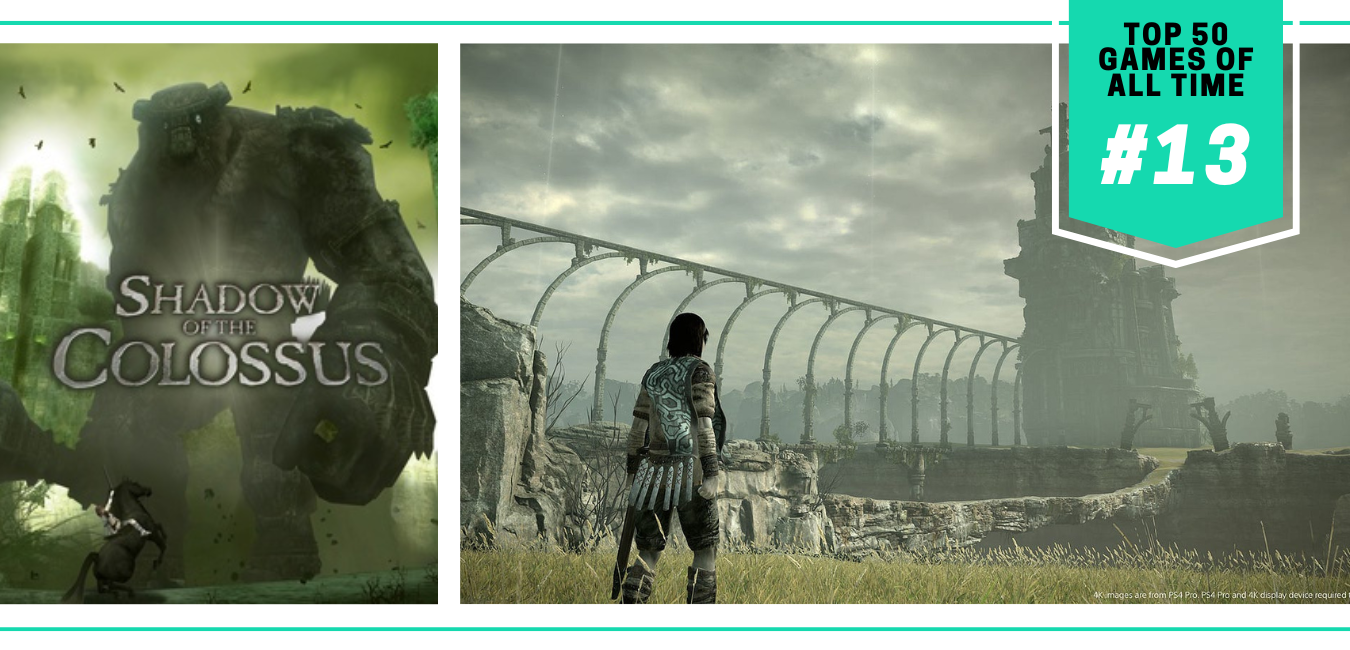
13. Shadow of the Colossus
Shadow of the Colossus is a game of contrasts. The protagonist, a youthful boy named Wander, rides atop his trusty steed Agro through a lush and verdant forest. There is abundant nature here: birds and lizards, butterflies and bees.
Moments later, a massive stone giant arises; rock grinds on rock, a guttural low roar emits from the beast, shaking the screen, and Wander sprints off, not much more than a speck in comparison to the majesty that he faces, alone.
Such is the nature of Shadow of the Colossus, a game that oscillates between contemplative serenity and visceral violence. The player controls Wander and his horse, Agro. Wander enters the Forbidden Lands with a comatose girl named Mono in tow, and is offered a proposal by a demon: Destroy 16 colossi, and the demon will bring the girl back to life. As with many stories, there’s a boy, and a girl. (And a horse.) And so Wander goes off on his quest to slay 16 colossi, and bring this girl back to life.
Words are sparse in Shadow of the Colossus, but somehow the game speaks volumes. A masterpiece in exemplifying the value of showing versus telling, it proves that the gaps that are left behind are more interesting to fill yourself than any answer that could come from the word of God. Is Wander saving a lover? A friend? Is his quest out of some sort of knightly obligation, honor-bound duty, intimate love, or something else? Why was Mono cursed—ritual sacrifice to appease a higher power, or is she being punished for something she did, or for the sins of others? People have wondered, discussed, and debated for decades now.
If there is anything final to say about Shadow of the Colossus, it is that it stands as one of the most evocative pieces of media ever. Even now, revisiting the original evokes that sense of wonder, of curiosity, of questioning. Yes, it has frame drops, janky hitboxes, frustrating camera controls, and a horse that moves like… a horse. But all of it comes together in a fascinating menagerie that to this day inspires awe, fear, wonder, and anything else you could ever ask of a game.
Platforms: PlayStation 2, PlayStation 3, PlayStation 4
– Written by Keisuke Isobe

12. Slay the Spire
Slay the Spire is an addicting roguelike deckbuilder, and arguably one of the best roguelikes of all time. Released by Mega Crit in 2019, the game sees you traverse floors of fantastical creatures and challenges as you try to make your way to the end. While your cards are your weapons, you can use potions and relics as power-ups to take down bosses and enemies. As you build your deck, you’ll obtain more powerful cards and upgrade them to become a better fighter.
As mentioned earlier, the gameplay loop is addicting, making you want to get better and better with each run. A typical run could last up to an hour (if you’re pretty good), and it’s VERY hard to make it to the end. Seriously, I don’t think I’ll ever beat Slay the Spire, but that doesn’t mean I won’t try.
Despite being an already awesome game, Slay the Spire’s music keeps me coming back. If I’m not playing it, I’m thinking about it. Even while writing this, I can’t get Slay the Spire’s soundtrack out of my head. It’s serious enough to help me get into the groove of battling enemies and climbing my way to the top.
There’s supposedly a sequel coming in 2025, which is a hyped game for many of us here at The Punished Backlog. If it’s like its successor, Slay the Spire 2 will come to us in early access for a while before reaching its full release. Regardless, I’m so excited for the future of this franchise. Give us more, Mega Crit!
Platforms: PC, Mac, Linux, PlayStation 4, Nintendo Switch, Xbox One, iOS, Android
– Written by Allison McDaniel

11. Bloodborne
Bloodborne is a once in a generation game. Its Lovecraftian aesthetic fuses with its quick gameplay to create an unrivaled FromSoftware experience. The developers wove such a grand playground in Yharnam that is equal parts exciting and terrifying. There are entire sections of Bloodborne that I wish I could hang on the walls of my office.
Playing as a Hunter also just feels great—even 10 years later. The combat forces players to unlearn bad habits created by other action and FromSoftware games before rebuilding the player for the unrelenting, gothic world that they are entering.
On a personal note, I liked FromSoftware games prior to Bloodborne. I loved FromSoftware games afterward. Bloodborne, however, is one of the few FromSoftware games that I care about the lore. The Old Hunters DLC only expanded the world further and gave us some of the strongest boss fights of the eight generation.
Bloodborne not only changed how I thought about playing the (what now feels like inevitably named) Soulsborne genre, but how I thought about game design as a whole.
Platform: PlayStation 4
– Written by Clint Morrison, Jr.
Our Top 10 Video Games of All Time
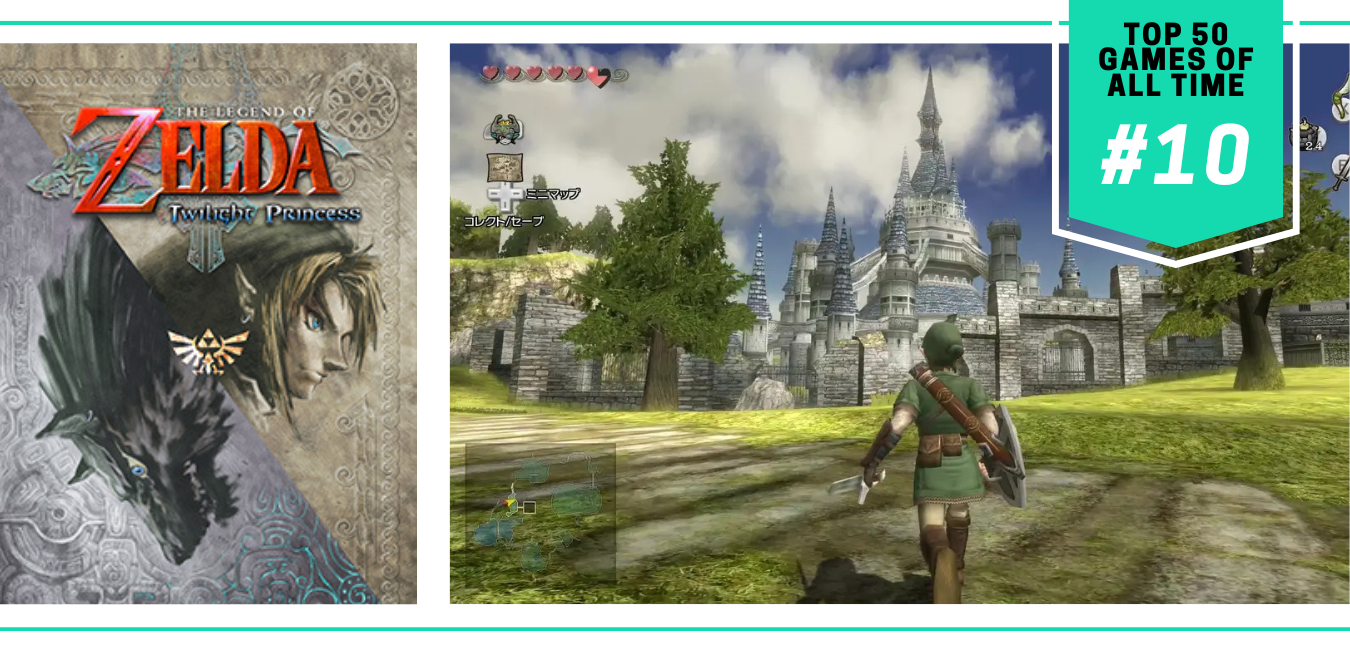
10. The Legend of Zelda: Twilight Princess
After its initial release in 2006, The Legend of Zelda: Twilight Princess was rereleased under the lower-priced Nintendo Selects label for the 25th anniversary of The Legend of Zelda in 2011, which is when my dad decided that we should get a Wii. The game came into my life at the perfect time—I’d entered the brave new world of middle school and had grown too important for the miscellaneous edutainment games that had punctuated my single digit years. With its beautiful graphics and dynamic gameplay (thanks, Wiimotes), Twilight Princess ignited in me a delight for storytelling in video games that made me a lifelong gamer.
Twilight Princess has a lot of experimental elements that fan the flames of controversy, like its more mature graphics style and winding plot. Gamers are often split between love and hate with this game. That said, I consider this polarization a sign of great art, as it suggests risks were taken.
I recently started replaying Twilight Princess, and the story is still just as impactful and moving as it was the first time, and the soundtrack is still incredible. My favorite moment continues to be “Midna’s Lament,” where Wolf Link rushes the good witch Midna to Hyrule Castle so Zelda can heal her. The atmosphere is desperate, the sky stays gloomy and dark, and the stress Link feels for her oozes off the screen. The characterization really comes to life in this sequence, and we see that Twilight Princess isn’t just about saving the princess—it’s a coming of age story about displacement, sacrifice, and responsibility. We’d only be lucky enough to get a remaster for a more modern console.
Platforms: Nintendo GameCube, Wii, Wii U
– Written by Alexia Dahlin

9. Red Dead Redemption 2
I must confess: I don’t know how to express my feelings for Red Dead Redemption 2 in just a few short words. This is my personal favorite game of all time, and it’s so expansive that you just can’t do it justice in this format… but here goes nothing.
Everything about RDR2 is perfect. The characters and their interactions are unbelievably real. The world is beyond immersive; it is living and breathing. The soundtrack is spectacular and haunting all at once. And the epic tale of Arthur Morgan is perhaps the most poignant, complex, and heartbreaking story I have had the pleasure of playing. Arthur’s tough outer shell gives way to his own mortality and questioning of his life’s choices as the gang pushes forward, trying to escape from a world that no longer accepts them. How much redemption he receives is up to the player—for me, Arthur had to find some semblance of it by the end of the game, and heading into the final mission, I found myself reflecting on his choices right there along with him (you know the song). No title has made me feel as much in tune with a character as I ever have with Arthur, and you have no choice but to feel the weight of his actions as the game goes on.
But it’s so much more fun than that, too. You truly never know what is around the next turn in RDR2. You can run into a mad scientist and help with his experiments. You can end up drunk in a bar where suddenly everyone looks like the same friend who you’ve lost track of. Or, you can simply take the time to admire the American landscape in front of you, one that is both outgrowing Arthur and serving as a reminder to the natural beauty of the country that continues to be threatened today.
Red Dead Redemption 2 feels like a tribute to America at the turn of the century – and not always in a romantic way. There are terrible crimes committed by groups in this game, and the consequences are real. People suffer from the effects of American expansion all over this game, with both indigenous and imperialist factions struggling over control of the land they claim as their own. It is a reflection of our own history, and who we still are in many ways. But despite it all, Arthur can offer a glimmer of hope to those who seek something greater in a sea of darkness. While Dutch and the gang may have a dream of America that is not attainable—and perhaps never was—Arthur learns that caring for those around you and giving up everything for them can in fact give you purpose, meaning, and, perhaps one day, even lead to redemption. And for that reason, Red Dead Redemption 2 surpasses any game in my book.
Platforms: PC, PlayStation 4, Xbox One
– Written by Mark Bowers
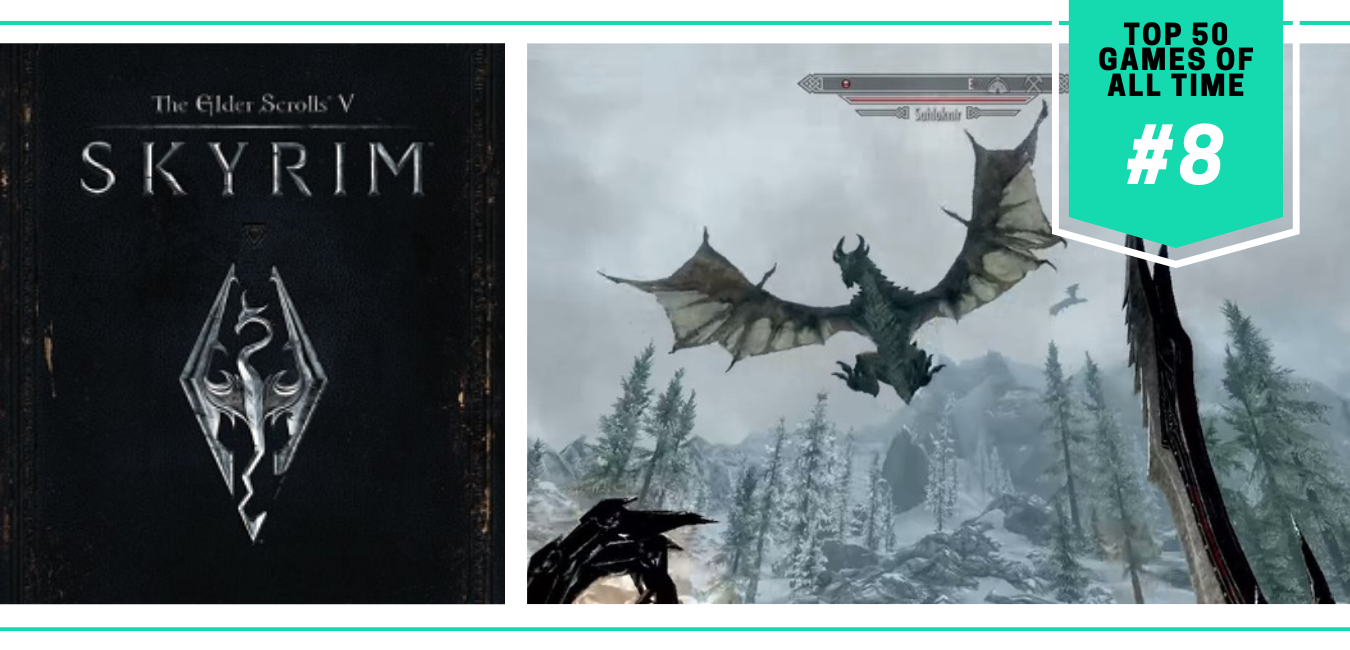
8. The Elder Scrolls V: Skyrim
Another giant from the 2010’s, The Elder Scrolls V: Skyrim is among the best open world RPGs ever made. The Elder Scrolls franchise is also the progenitor of dozens of beloved memes, and Skyrim is one of the most prolific meme producers. This may be partially due to its excruciatingly detailed and charming worldbuilding, and also partly due to its longevity; Skyrim has maintained its status as a gaming mainstay for almost 15 years now.
At its core, though, Skyrim is a role-playing game. You are the Dragonborn, sure, but you can be so much more. The game doesn’t limit the player to a single faction except in a few cases, like choosing between the Stormcloaks and Imperials. The world also feels much more alive than many other more recent RPGs. There are secrets hidden everywhere. The player can interact with almost everything. NPCs actually notice you (unless you put a basket over their head). And while some of your choices don’t necessarily have lasting consequences, your actions do. Stab a chicken? Good luck ever visiting that town again. Kill someone you shouldn’t have? Guess what, there are assassins after you now.
The freedom to play through so many permutations of the game with only one save file is part of the appeal of Skyrim. It gives you time to explore the whole world at your leisure and, before you know it, you’ve sunk hundreds of hours into a single playthrough (without even downloading mods yet!). I’ve spent those hours walking across Skyrim, finding secret chests, and gathering every accolade and title in the game. I know I have hundreds more hours left in my adventuring career. No arrow to the knee will stop me.
Platforms: PC, PlayStation 3, Xbox 360, PlayStation 4, Xbox One, Nintendo Switch, PlayStation 5, Xbox Series X/S
– Written by Alexia Dahlin
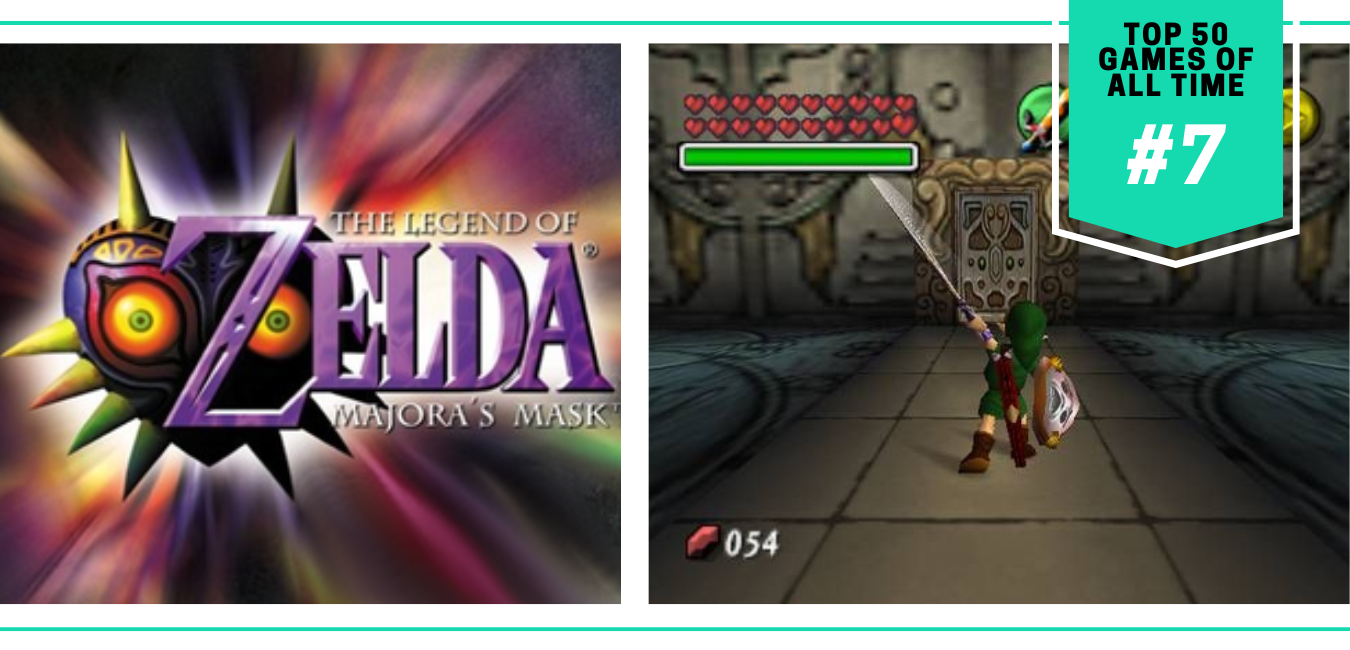
7. The Legend of Zelda: Majora’s Mask
When I first tried The Legend of Zelda: Majora’s Mask by way of the Nintendo Wii’s Virtual Console, I wasn’t sold on it. The game seemed archaic in many respects, from the controls to the combat to the camera. I had always loved a good 3D Zelda growing up, so it pained me to put Majora’s Mask back on the (digital) shelf.
When I eventually dusted off the cobwebs, it was years later. I had retired my Wii for a Wii U and was busy playing games of Super Smash Bros. in college. The 3DS had come to prominence, and I had a backlog of titles I wanted to enjoy in handheld form. So, when Nintendo and studio Grezzo announced a 3DS remake, The Legend of Zelda: Majora’s Mask 3D, complete with a statue of Skull Kid, I jumped at the chance.
Goodness, how wrong I was years back. Majora’s Mask slapped! The game took the sprawling open world of Ocarina of Time and layered on two fundamental additions that solidified its greatness.
The first is the clock “gimmick”—only it isn’t a gimmick at all. Every person in Termina, from the shopkeepers in Clock Town to the band members in Zora’s Domain, abides by the same 72-hour schedule. Shops open and close; townspeople go about their business. Idle for too long, and you may miss a critical side quest, mask, or mini-game—that is, until you rewind and do it all again. The system was ingenious, making for a game world that felt both broad and dense. Even today, modern Zelda NPCs can’t hold a candle to those in Majora’s Mask.
The second addition: darkness. If Ocarina was a grandiose, uplifting adventure, then Majora was the twisted, nihilistic evil twin. That isn’t to say the former was a basket of rose petals—the screams of the dead in Ocarina’s Castle Town will forever follow me—but Majora’s Mask simply dialed that vibe up to 11. From the mask salesman’s chilling smile to the impending doom of the moon, or even just the crazed animation of Link putting on a new mask, Nintendo took this game in a gleefully bizarre direction.
Majora’s Mask is much like Link’s “Song of Healing.” It’s tragic, yet nevertheless magical, with plenty of beauty to balance out its most haunting moments.
Platforms: Nintendo 64, GameCube, 3DS, Switch (via Nintendo Switch Online + Expansion Pack)
– Written by David Silbert
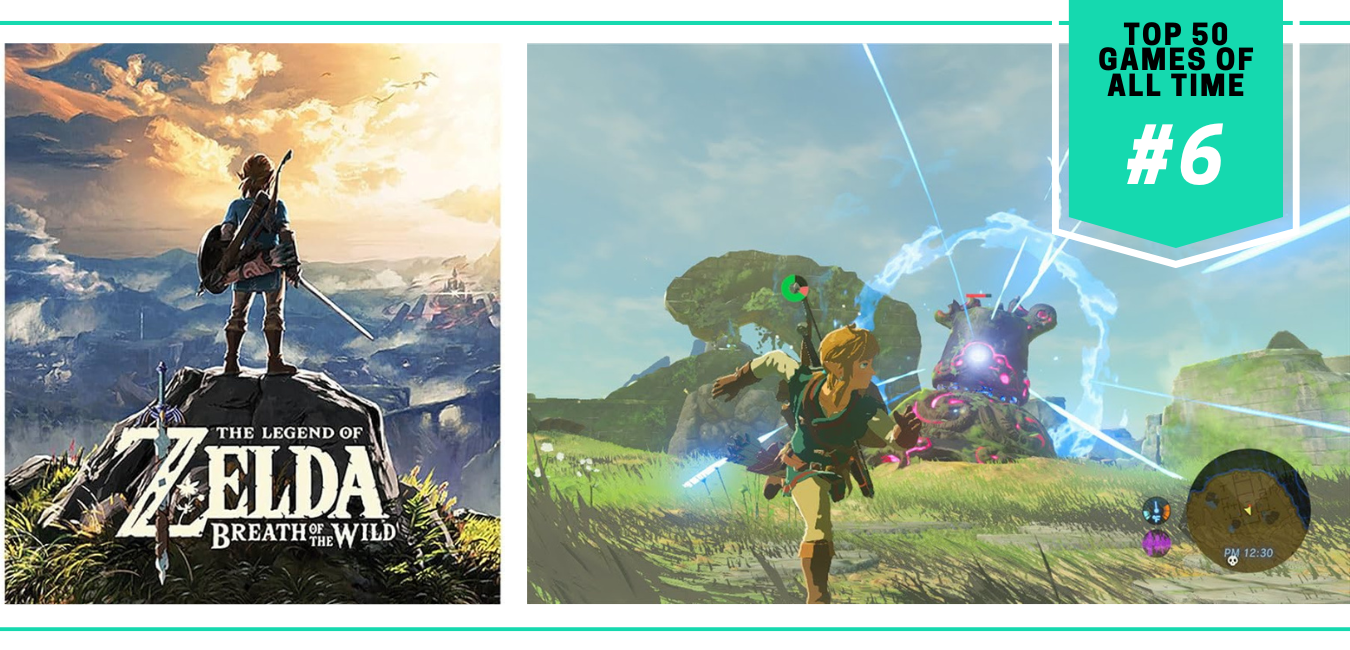
6. The Legend of Zelda: Breath of the Wild
Everything that could be said about The Legend of Zelda: Breath of the Wild has been said already by people far more eloquent than I. The detail and care given to Hyrule is amazing, the experience is adventurous and enthralling, and the story is simple but confident. It was a bold step for the storied franchise, which needed new direction after the ups and downs of the Wii U era.
But after all that, what has stuck with me the most about my time playing Breath of the Wild was the awe-inspiring sense of quiet throughout the game. Here is the big world that once was bustling and has now fallen to natural ruin. There is no great desolation, just moss-covered buildings and small pockets of survivors. It’s a lonely world for Link as he travels the grass-covered hills and glide over glades. You can hear the wind as it whips by, feel the sense of empty around you without the world feeling dead. Hyrule felt still the way a forest feels: alive but quiet.
No game has touched that atmosphere before or since. The joy I felt when I heard an accordion in the wind, a small touch that someone else is out here with me is impossible to replicate. While many open-world games can feel empty, as in a lack of content, Hyrule felt empty in a different way. It felt lonely and somber and sad, and it was my job to journey through it and free the world from that loneliness. To bring light back to the world and wake it from this quiet dream. A one-of-a-kind experience.
Platforms: Nintendo Switch, Switch 2
– Written by Gary Wilson
Our Top 5 Video Games of All Time
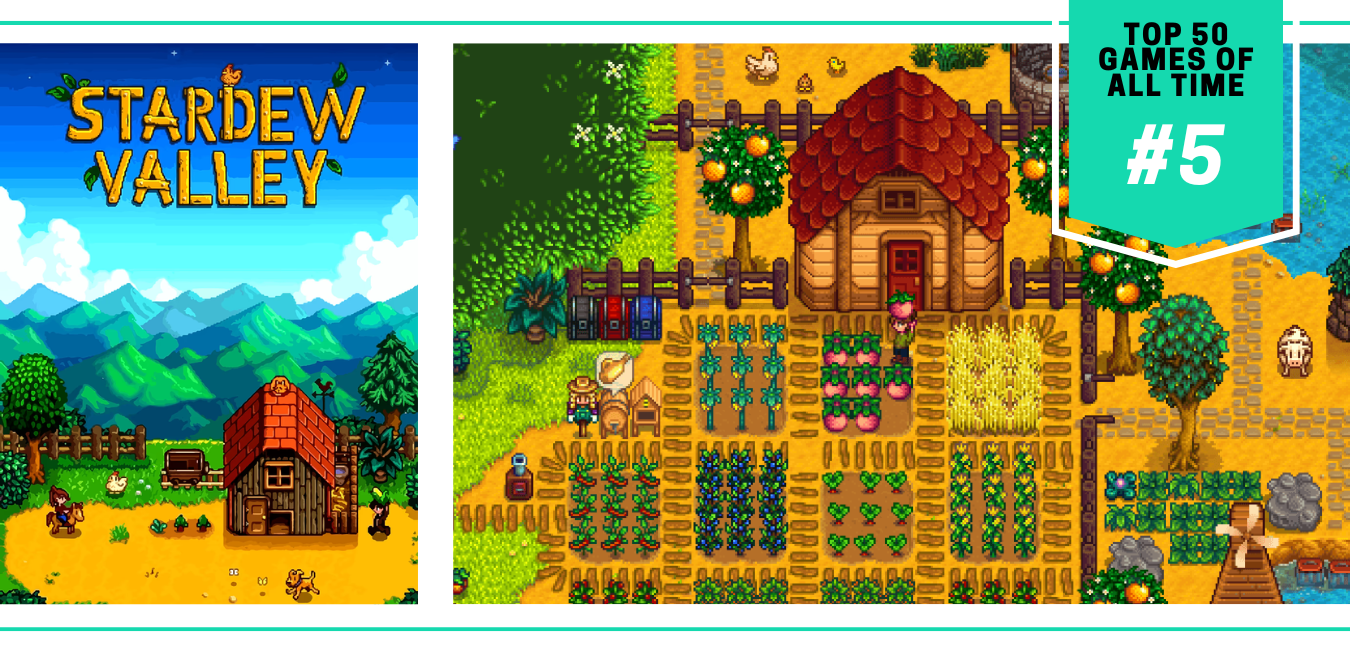
5. Stardew Valley
It should come as no surprise that Stardew Valley is number five on our list. This nine-year-old classic farming sim is arguably the best in its genre, despite being inspired by early Harvest Moon games, which defined the space for decades. Developed by ConcernedApe, aka Eric Barone, Stardew Valley is so popular that it continues to see massive free updates regularly, bringing loads of extra gameplay to players.
The story of Stardew Valley is similar to most farming sims. Your character is tired of life in the big city, so they move to their deceased grandparent’s farm to start a new life. What sets Stardew Valley apart from other farming sims is its charm and depth. Not only do the characters feel real, but they have deep, interesting backstories that desire to be explored.
Possibly the best part of Stardew Valley is its music. Also composed by ConcernedApe, each track is a banger, and knows how to hit your feelings. My favorite tracks are the ones played during spring. They’re so cheery and upbeat and never fail to improve my mood if I’m feeling down. The soundtrack is so good that there’s an orchestra concert called Stardew Valley: Symphony of Seasons with worldwide performances.
Stardew Valley is a fantastic indie game featuring hundreds or thousands of hours of gameplay. There’s so much content to uncover, and I look forward to future games from ConcernedApe. He’s truly a gem we don’t deserve.
Platforms: PC, Mac, Linux, PlayStation 4, Xbox One, Nintendo Switch, PlayStation Vita, iOS, Android
– Written by Allison McDaniel
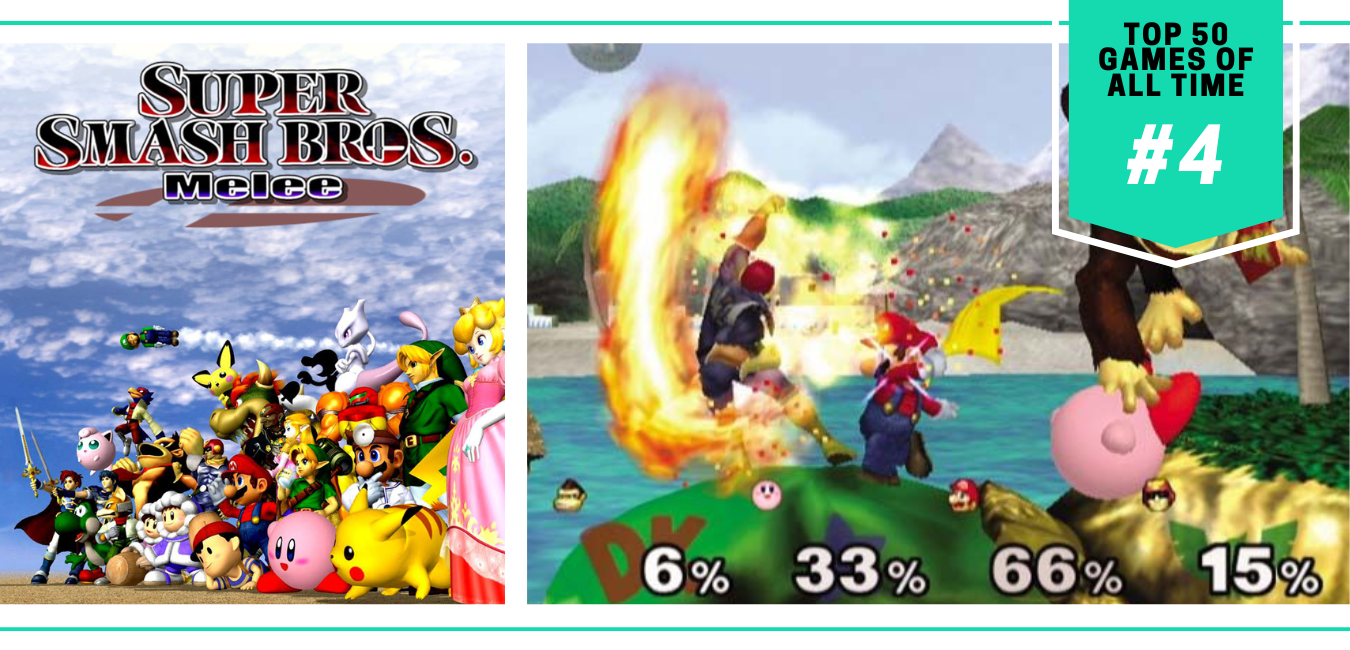
4. Super Smash Bros. Melee
Why Melee over any of the others? Yes, Super Smash Bros. (N64) has a claim, as the progenitor of it all; Brawl was on a wildly more popular console and marked the beginnings of Smash as more than a celebration of Nintendo but a celebration of gaming as a whole; Smash for Wii U… okay, that one probably doesn’t have a claim. But Ultimate? It’s even in the name!
I promise this isn’t just some sort of competitive Melee spiel (though we’ll touch on it). What is it about Melee that’s so special? 64 is a fun game, but it started as a prototype for something else and in some ways feels that way: a stripped-down version of what the series would eventually become. Brawl has its high points: Subspace Emissary isn’t an incredible gameplay experience, but the cutscenes are a joy to watch, and the inclusion of Solid Snake and Sonic the Hedgehog certainly opened the floodgates later down the line. Ultimate is, well, ultimate, with a mind-bending 89 playable characters across decades of gaming history crossing third-party lines. So why Melee?
Well, to be frank, selection bias plays a part. For the writers on this site, Melee came when we had the most free time, so it checks out that it was chosen. But there’s more to it than that. Gameplay-wise, Melee is the game that really solidified and defined the formula for the series to come: side-specials and all those sorts of things, yes, but more importantly the adoption of the GameCube controller, which feels integral and core to the idea of Smash Bros. now. Melee is Smash before it was a load-bearing pillar of the Nintendo ecosystem, a gaming institution unto its own, where earning a place in the game determined something about a character’s worthiness.
But it’s more than nostalgia: Melee is a game that we just keep coming back to, and it doesn’t have to be in a competitive sense, either. If I were to pick any two Smash games to keep forever, it would probably be “whatever the newest one is” and Melee. It’s faster, snappier, and just feels good to play. Its graphics are, in a sense, strange: I once read someone’s description of it as plasticine, and that fits perfectly. The menus are this strange Y2K vision of cyberhell, and there’s a certain horror to it all.
And in the end? There’s so much more Melee to be played. What is dead may never die.
Platforms: Nintendo GameCube
– Written by Keisuke Isobe
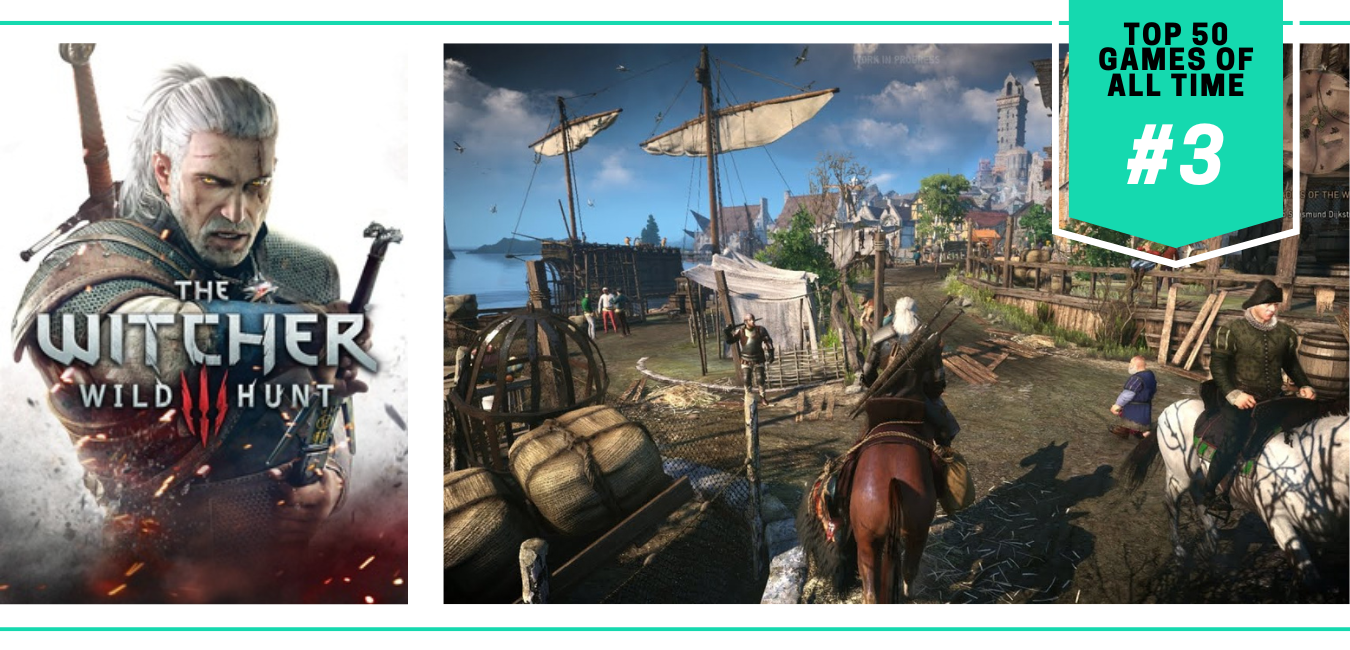
3. The Witcher 3: Wild Hunt
The Witcher 3 is nothing short of a masterpiece. The series has always excelled in telling excellent stories grounded in the flaws of humanity, and the third entry delivers an enthralling tale of political ambition, destiny, and the fate of the world.
When you enter the story, you find yourself thrust into chaos: An ongoing war has split the countryside and its authority, leaving villages caught in the crossfire while monsters run amok. Persecution continues for the dwindling populations of elves and dwarves, and mages are being hunted and executed for their abilities. All the while, the evil Wild Hunt pursues Cirilla across the realm, creating a devastating path of destruction for Geralt to follow in order to discover the fate of his protégé.
Despite these upheavals, most of the game involves riding around the world on your trusty steed, Roach, and enduring the dangers of the roads. You could ride through a village and stop to pull down their vague monster slaying request from a bulletin board, or find yourself surrounded by Rotfiends in a swamp. However you handle the task at hand (if at all), you’ll come out stronger because these are the quiet moments of peril that define a Witcher. Along the way, you’ll also pick up stronger gear, explore new areas, and run into familiar faces (for better or worse).
Geralt thrusts himself into peril for the sake of those he loves and as a natural extension of his profession. While the latter offers an adrenaline rush for the player, it’s the former that keeps the story mesmerizing. The characters of The Witcher 3 are colorful, providing us with intricate conversation and mirth one moment, then front and center fighting through a bloodbath the next. As you navigate their requests and hidden motives, you quickly find out the bonds you cherish and those you keep at sword’s length. Ultimately, it’s these relationships that change the world and your choices which shape it.
The Witcher 3 was my lockdown game and honestly made being alone in the middle of a pandemic a barely tolerable existence. Never have I played a game where I felt more enthralled with the characters and their outcomes, nor in control of world events quite like this one. With an impeccable soundtrack, unforgettable scenery, and some of the greatest writing in gaming, The Witcher 3 is remarkable. Yet, there’s never enough time with the legendary White Wolf, Butcher of Blaviken, Gwynbleidd, Geralt of Rivia.
Platforms: PC, PlayStation 4, Xbox One, Nintendo Switch, PlayStation 5, Xbox Series X/S
– Written by Vaughn Hunt
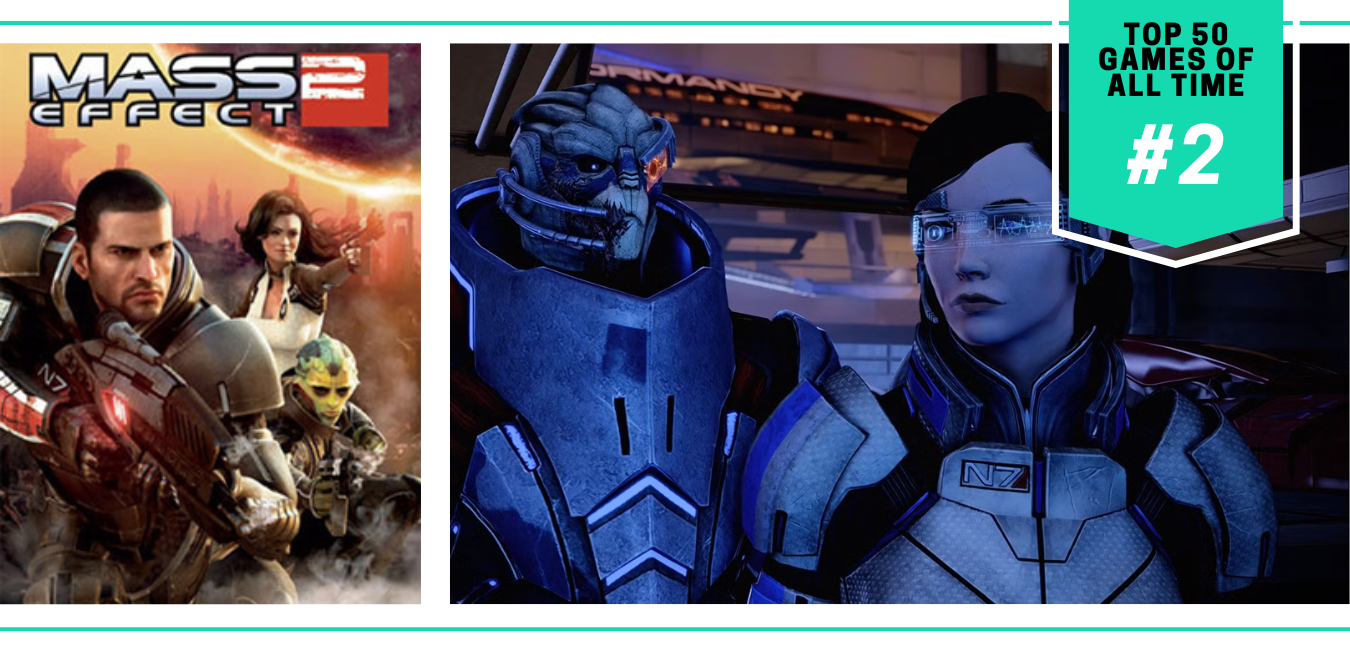
2. Mass Effect 2
Mass Effect 2 is an almost constant presence on “Best Games of All Time” lists, so much so that there’s a “Legacy” section on its Wikipedia page just to highlight these accolades. Most second titles in trilogies are awkward, suffering from the weight of the first without being buoyed by the energy of the finale. And yet, Mass Effect 2 is what sticks out in people’s minds.
The reason is simple: The characters and quests are just so damn good. Mass Effect 2’s companion-driven side quests are completely optional, and yet, that’s where all the best stuff is. It’s like Thanksgiving, where the turkey is cool you know but it’s really all about the mashed potatoes, the stuffing, the mac’n’cheese, the pie. Furthermore, the main quest compels Commander Shepherd and her crew ever forward on a race against time, a road trip into hell, a fight to the end.
The Mass Effect trilogy is my favorite game series of all time. They were the first games I truly played independently as an adult. I love the action hero space drama of it all. In a lonely year in a new city, my fictional crewmates were some of the best friends I had. The combat is straightforward. The story builds over the course of the game, hundreds of hours layering on top of each other more similar to a long-running television show or book series. Fellow writer Sam Martinelli even called it the franchise that defined the Xbox 360/PlayStation 3 era of the 2000s.
But the reason that the Mass Effect games are the most important to me was a simple choice at the beginning of the first. Players can pick Commander Shepherd’s background from one of three options, including Spacer, the child of military space leaders always on the move. I grew up as an Army Brat, and I very rarely see my upbringing represented in the media. These background choices added a little bit of flavor text, occasionally impacting one or two small side quests, but to me, it was monumental.
Mass Effect 2 is a crescendo that has gamers, journalists, developers, and experts remember, and in art, that is sometimes everything.
Platforms: PC, Xbox 360, PlayStation 3, PlayStation 4, Xbox One
– Written by Amanda Tien
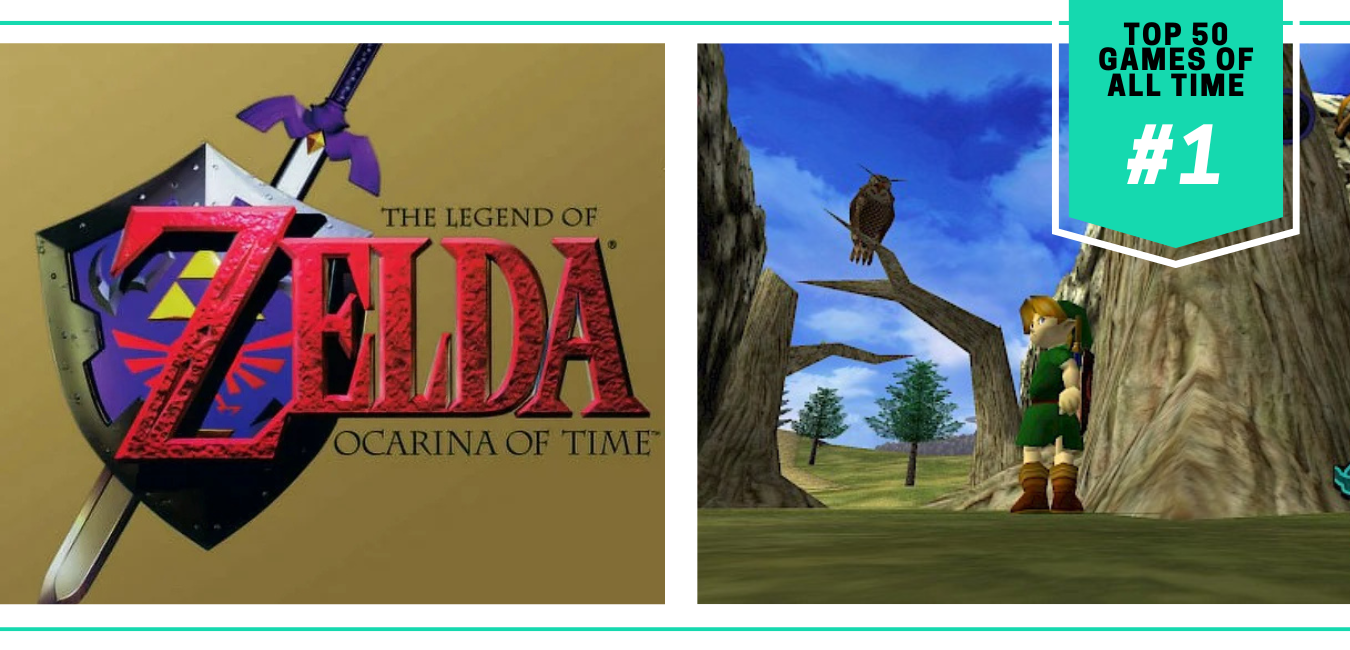
1. The Legend of Zelda: Ocarina of Time
It’s basically impossible for me to adequately describe why Ocarina of Time remains my favorite game ever made. Seriously, I’ve tried many times to write some kind of epic, heartfelt essay on the ways it connects me to my childhood (and my relationship to my older brother, whom I watched play it before trying it myself); how its darker, more brooding themes are more relevant to me in my 30s than they were in my youth; and how it’s probably more innovative and creative mechanically than most people think. Ultimately, though, if I had to boil down the impact of Ocarina of Time into something brief, I’d say it’s why I do this.
I’ve adored video games ever since I was old enough to even process what they were. The titles I remember playing in my early years continue to fill me with joy (especially ones that are on this list), and I genuinely believe there’s so much more we can learn from them than we realize. Still, unlike the various Mario, Pokemon, and Donkey Kong games that dominated my childhood, The Legend of Zelda: Ocarina of Time was more than just another vibrant adventure with charming characters and exciting boss battles. It was the first game that convinced me, even at such a young age, that this medium could be more; that digital stories weren’t just kids’ toys, but vessels for creative storytelling with near-unlimited potential.
Any description of Ocarina of Time tells players of an exciting but in many ways rote experience: young, brave outcast utilizes unique tools to save the kingdom (and the princess), traveling through bizarre and at-times hostile locales to gather various macguffins and learning a number of important life lessons along the way. But what makes this 1998 treasure the greatest video game of all time is not how—for its time, at least—it masterfully executed on these cliches, ushering in a new era of 3D gaming and creating a new standard for open-world adventures. Rather, it’s how, a dozen playthroughs later, I’m still as enchanted as ever by each song on the ocarina, every dungeon puzzle, and all the townsfolk of Kakariko Village, Goron City, and Castle Town. I’m still in awe of how the world changes when you switch between Young Link and Adult Link, and I still feel that tingle in my spine when I see the despicable Ganondorf levitating before me in the final showdown. I still find new details that amaze me every time I go back to that version of Hyrule, and I still love what I already loved 27 years ago.
Whenever you read what I write here at The Punished Backlog, know that I do so because of my experiences with The Legend of Zelda: Ocarina of Time. When you see me posting online about the games that shaped my very understanding of the medium, you’ll always see me mention Ocarina of Time first. Whenever you hear me speak on an episode of The Punished Podcast, keep in mind that any thoughts percolating in my brain on gaming truly started once I played Ocarina of Time. It’s why I write about games, why I think constantly about games, and why I really care about games. Nothing else could be number one.
Platforms: Nintendo 64, GameCube, 3DS, Switch (via Nintendo Switch Online + Expansion Pack)
– Written by Sam Martinelli
More “Best Video Games” Recommendations
Want more content like this article? Check out our platform- and genre-specific lists:
Best Platform-Specific Video Games
Best Genre-Specific Video Games
What Are Your Favorite Video Games Ever?
What did we miss? What video games do you think need to be among the top 50 ever made? Let us (politely) know in the comments!


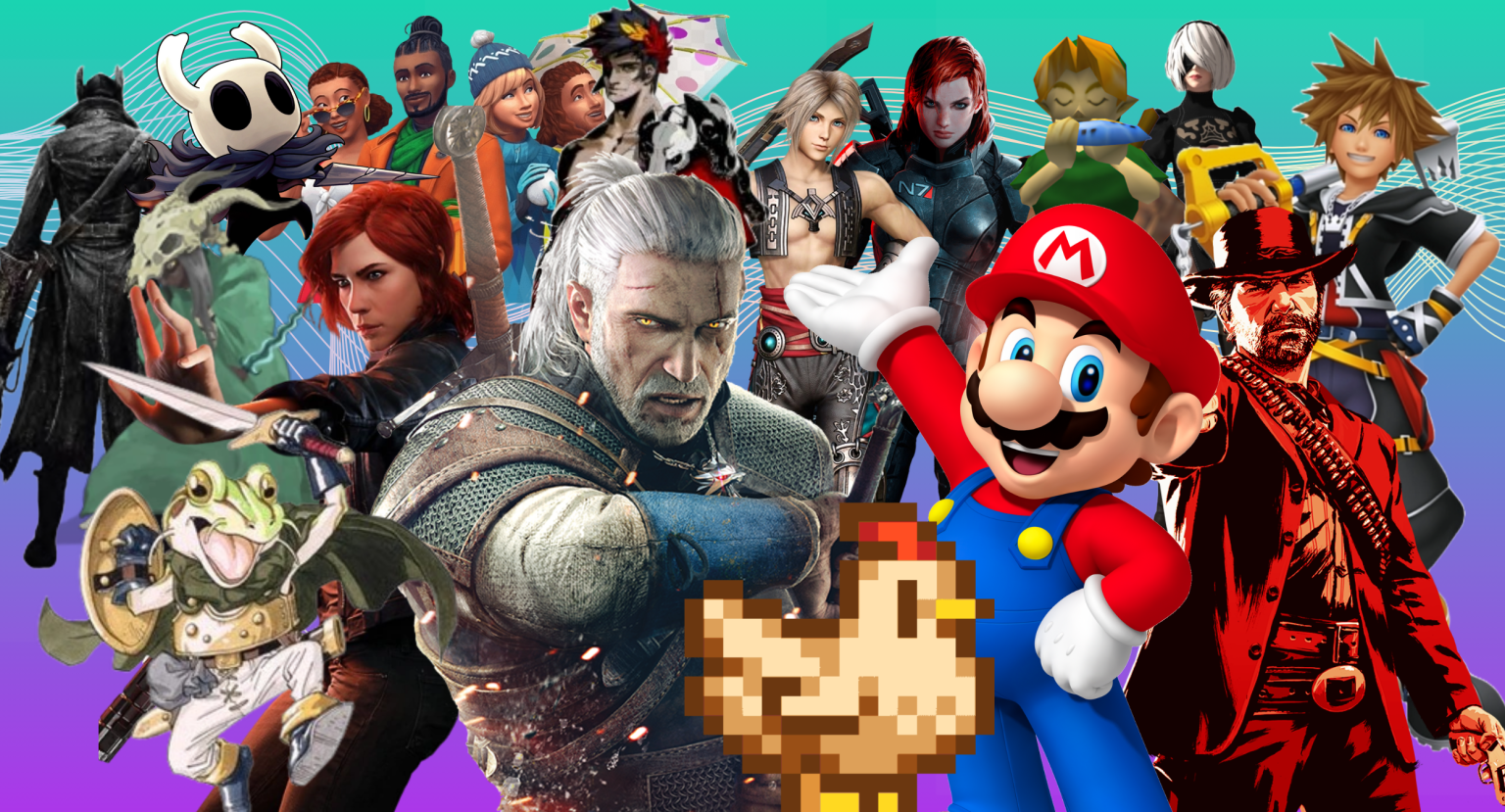












































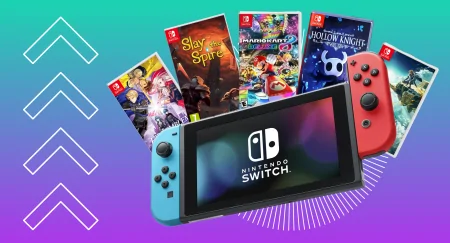

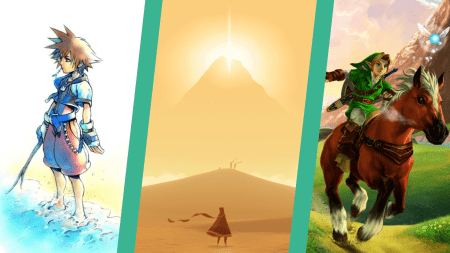

wow, way to not include cooking mama lol jk GO BALATRO
Minecraft????
I never understand the love for Majora’s Mask. I tried it, and I wouldn’t put it in my top 10 Zelda games, let alone top 10 games of all time. I’m glad Twilight Princess got some love though.
More like to play
Such an awful list
Give us yours then, hotshot.
This “All-time” list belongs in hell. I know it has to be ragebait, I just can’t prove it. I cannot fathom how anybody could ever, in their lives, possibly, put this together with a straight face. People like this are the reason gaming as a whole is in the state it is in. My little brother is 17 and won’t play a game if it doesn’t have next gen graphics. He would put together a more tasteful top 50. I’m surprised the top 10 isn’t just Legend of Zelda games. Im also surprised you didn’t go ahead and put a… Read more »
Thanks for your support, Allen! Glad you loved the list 😀
yeah this list is kind of mid rdr2 is definitely top five all the old Zelda games are just nostalgia
Super Mash Bros at #4 on a list without Street Fighter 2 is wild.
Edit: I see this is a list of favorites, not objectively the best. So that makes more sense. But giving the list a relook now my guess is y’all are young as hell.
We’re probably older than you think, haha.
Put roblox in the list,please.
YES he is ragebaiting guys
Fallout?
I could have not said it better in regards to OoT and I also grew up watching my older brother playing before me and pulling all nighters just to watch him play. My first play through I felt like was me a boy becoming a man LOL
Disappointing. Notable missed games:
– The Last of Us
– A Plague Tale: Requiem
– Fallout (Any of them)
– Far Cry (3 or 5)
Plus having RDR2 so low!
I would have also included The Sims 2 rather than The Sims 4.
Sims 2 was ahead of its time, whereas Sims 4 took a huge back step from its predecessor.
Minecraft is obviously top 3 no matter what. This list is terrible
If Outer Wilds isn’t on this list, the whole list is completely unreliable
Thank you for the list! It gave me some new games to go try. I do feel like you have to put The Last of Us in here though. No game can compare with the way TLOU tells a story. It’s literally left a void in my video game life that I haven’t been able to fill with anything else.
why is mincraft, roblox and the last of us not here. ALSO, why is Zelda soo high, even higher than rdr2 and gow
Made by a 5 year old
Where’s Frogger?